CANADA: True
Patriot Love Foundation launches Highway ...
nova0000scotia.blogspot.com/2016/.../canada-military-news-western.ht...
A bare-chested Viking offers a slave girl to a Persian merchant in an artist’s rendering of a scene from Bulgar, a trading town on the Volga River.
-----------
Viking
Answer Lady Webpage - Risala: Ibn Fadlan's ...
www.vikinganswerlady.com/ibn_fdln.shtml
1.
2.
No
standard measure is known in the land; they buy and sell by dry measure. ... The Rus are a great
host, all of them red haired; they are big men with white bodies. ... Note: The preceeding two
paragraphs are from the 16th century C.E. Persian ... With them are pretty slave girls destines for sale to merchants: a man
will ...
-------------
Saudi Aramco World : Among
the Norse Tribes: The ...
archive.aramcoworld.com/.../among.the.norse.tribes-the.remarkable.acco...
1.
The Vikings' network
of arduous riverine trade routes connected settlements from ... and other kinds
of skins, which they sell to those
who will buy from them," he observed. ... Ibn Hawkal, writing in 977, the
Rus slave trade ran
"from Spain to Egypt. .... Hedeby was noisy and filthy, he
wrote, with the pagan inhabitants hanging ...
Missing: white
-----------------
sidebar b4 we start-
WHY IS TURKEY IN NATO.... AND TO B PART OF EU.... ewwwww- when they have such a romantic and beautiful ...and yes violent history... but didn't they all
Putin’s description of what happened as a “stab in the back” by “supporters of terrorists” is the first official acknowledgement of Turkey as a state sponsor of terrorism
------------
Old Arabic texts describe dirty Vikings
July 17, 2013 - 05:00
Arabs who encountered Scandinavians who had journeyed eastward depicted them as handsome people but filthy and barbaric.

The Polish painter Henryk Siemiradzki painted the funeral ritual of Vikings in what is now Russia, in accordance with descriptions by Ahmad ibn Fadlan. New analyses show that his and other Arabs’ texts are excellent sources of cultural knowledge about the Vikings who ventured eastward. (Photo: Wikimedia Creative Commons)
The Arab writer Ahmad ibn Fadlan noted the above after meeting Viking travellers around a thousand years ago.
The Icelandic historian Thorir Jonsson Hraundal has studied comments about what we call Vikings in original texts by Arab historians and geographers. The texts described Arab encounters with Scandinavians in areas around the Caspian Sea and the Volga River.
Their depictions differ radically from images of fearsome Viking conquerors handed down from the British Isles and France in the same era.
Resilient Scandinavians
“A major difference between the Scandinavians who travelled eastwards and those who sailed west was that in the East they were far more subordinated in societies they came to,” says Jonsson Hraundal.He recently presented his doctoral dissertation at the University of Bergen about the so-called Rus ― Scandinavian merchants and warriors who travelled to Eastern Europe, Central Asia and the Middle East.
“The Scandinavians appear to have been versatile people who were really good at adapting to diverse regions and participating in various power structures,” he says.
From the Nordic region to Baghdad
From the mid-800s until the ca. 1000 AD Scandinavians underwent something of a travel boom. The Vikings journeyed out into the world to explore, trade and battle. Norwegians are best acquainted with the raids in Western Europe and the voyages to Iceland, Greenland and North America.According to Jonsson Hraundal it might have been nearly as common to head eastwards, using the major European rivers.

The coloured area indicates the Khazars’ territory, one of the regions where travelling Arab writers describe having met Vikings. (Image: Wikimedia Creative Commons)
The excursions in the direction of the sunrise were also extensive. A source studied by Jonsson Hraundal tells of Vikings who followed the European rivers down to the Caspian Sea and then crossed by boat and continuing to Bagdad on camel caravans.
It’s a distance of over 5,000 kilometres.
Visiting Turkish-ruled countries
Scandinavians were encountered in the eastern regions of the Continent for centuries. They were warriors, merchants and common labourers.Some sources mention Vikings working as caravan guards – mercenary soldiers.
“Archaeological sources placed Vikings further west, but Arabs mainly confronted them closer to the Caspian Sea. This was a completely different cultural setting, one governed by Turks,” explains Jonsson Hraundal.
Turks are an ethnic group who include the people of modern Turkey, but many other peoples as well. Like Mongolians they descend from the Ural Altaic ethnic group.
“The Turks, and especially the Khazars and Bulgars, were the dominant powers in the region when the Rus arrived. The texts mainly show how powerful the Turks were. The Rus couldn’t just come in swinging their swords and take over,” says the historian.
Good looking, filthy and crazy
The aforementioned writer Ahmad ibn Fadlan was not fully repulsed by the Scandinavians he met:
In the manuscripts from Ahmad ibn Fadlan and others, Jonsson Hraundal has extracted some new knowledge about how Vikings behaved in the East. (Photo: Gilwellian/Wikimedia Creative Commons)
Ahmad ibn Fadlan describes funeral rites which generally conform to the Norse rituals of Scandinavia, but were very exotic for an Islamic intellectual:
In the case of a rich man, they gather together his possessions and divide them into three portions, one third for his household, one third with which to cut funeral garments for him, and one third with which they ferment alcohol which they drink on the day when his slave-girl kills herself and is burned together with her master.
Contemporary Arabic descriptions
It’s no news that the Vikings travelled eastwards. But archaeologists and historians have few sources detailing the travels. In Norway, for instance, written material about the journeys dates from long after the trips ended. This undermines the validity of the texts as historical source material.The archaeologists have thus concentrated on artefacts from Byzantium, in present-day Turkey, and from Slavic areas such as Hungary.
“However, Muslim authors also travelled and met Scandinavian merchants. They made note of these episodes at the time they occurred,” says the historian Jonsson Hraundal.
This makes them excellent first-hand sources regarding the kind of people the Rus were.
Silver coins testify to contacts
For a number of reasons, the East-bound Vikings have been neglected by scholars in comparison to those who headed west. Political problems hampered Western archaeologists for decades. During much of the 20th century it was hard for West European researchers to access artefacts collected behind the Iron Curtain.“We have a lot more source information from the West because of the linguistic and writing culture that dominated there,” adds Archaeology Professor Jan Bill of the University of Oslo.

Thorir Jonsson Hraundal (Photo: UiB)
There are exceptions and Bill mentions that Arab silver coins and other artefacts from Kazakhstan and neighbouring areas have been found at Heimdalsjordet, a former marketplace not far from the Gokstad Viking Ship Mound in Sandefjord, southwest of Oslo.
“They come from the Silk Road and show that the Vikings definitely had contact with Islamic areas,” he says.
Deserving more emphasis
Another barrier is that the Arabic texts lack names for the Scandinavians they described, unlike many of the Western sources. The Arabs have evidently viewed them as a homogenous group, and haven’t considered the name of any incidental northern “infidel” relevant to the travel journals they wrote.This makes the protagonists anonymous and for historians perhaps a little less enticing to study.
Jonsson Hraundal hopes his doctoral thesis can help open up more studies of what the Vikings did in the East.
“The Scandinavians who travelled eastwards are generally mentioned briefly in passing by textbooks and in school. I think this part of our history should be given much more attention,” he says. http://sciencenordic.com/old-arabic-texts-describe-dirty-vikings
--------------------------
---------------
Which countries in the Middle East hate each other and why?
8 Answers
ETA: I included countries from the Greater Middle East. A few people have argued that the Middle East doesn't include some of the countries I mention below. My response is that the "Middle East" is itself a relatively new, Eurocentric political term, so the boundaries are naturally fuzzy.
1)Israel and pretty much everyone else, due to the Arab–Israeli conflict. Many Arabs (and non-Arab Muslims) see the existence of Israel as essentially an invasion of their land, while many Israelis see Arabs as an existential threat. Israel even has issues with some of the more pro-Western countries in the region, like Turkey and Saudi Arabia. Israel does get along pretty well with Jordan, and had good relations with Egypt until the Arab Spring (Egypt's foreign policy going forward is unclear). Iran seems like the most vocal opponent to Israel at the moment, and Iranian nuclear ambitions aren't helping relations. Israel has talked about bombing Iran's nuclear reactors.
Countries that don't recognize Israel are in green:

2)The GCC vs. Iran. The GCC is an Arab group of Sunni monarchies (led by Saudi Arabia) that's friendly towards the US, while Iranians are mostly Shi'ite and the country is an anti-US theocracy. The two sides contest each other in regards to Middle East dominance, energy production, and control of the Persian Gulf. Iran is allied with Syria, which is in turn allied with the Lebanese group Hezbollah.
The GCC is in purple:

3)Armenia vs. Azerbaijan and Turkey
Armenia and Azerbaijan currently have a closed border, and each country contests the other's territory. After the fall of the Soviet Union, which granted independence to the two countries, they fought a war over Nagorno-Karabakh, a de jure part of Azerbaijan that is dominated by ethnic Armenians. Armenia dislikes Turkey because of the Armenian Genocide. Azerbaijan and Turkey are both Turkic peoples, and the two are allied.

4)Pakistan vs. Afghanistan
The two have a complicated relationship. Afghanistan believes that Pakistan is trying to use the Taliban and other groups to project their influence into Afghanistan, while Afghanistan serves as a source of instability for Pakistan. The Pashtun people, who number over ten million in each country, are split between the two states. The two countries have had border skirmishes.

5)Turkey v. Syria
The two countries got along until the Syrian civil war. Turkey has condemned Syria's response to the Syrian uprising that occurred in the wake of the civil war, and there have been border clashes between the two countries. At this point, Turkey is perhaps the greatest backer of the rebels opposing the rule of Syrian President Bashar al-Assad.
Green means control by pro-Assad forces, brown is anti-Assad, and blue indicates ongoing fighting.

6)Algeria v. Morocco
The border is closed between these neighboring countries. Algeria supports the independence of the Western Sahara, which Morocco seeks to control. The two have accused each other of involvement with terrorist organizations in each other's territory. However, tensions have been lowering recently.
Algeria is in green, Morocco is in orange, Western Sahara is in the pinkish color.

7)Turkey v. Cyprus
Turkey supports Northern Cyprus, a breakaway territory populated by ethnic Turks. The Turks in Cyprus attempted to secede due to fears about being dominated by the Greek majority. Until the political status of Cyprus is resolved, the two countries will likely remain rivals.

8)The Sunnis of Iraq v. Iran
The two countries fought a war in the 1980's, and the Shi'ites of Iraq are close to the Iranians. Sunnis would like to avoid domination by Iran, which also plays a role in the ongoing sectarian conflict.
Blue is Sunni-populated territories, and red is Shi'ite territories.

9)Non-Shi'ites of Lebanon vs. Syria
Hezbollah is a paramilitary group and political party that represents the Shi'ite population of Lebanon. It was Hezbollah's activities that precipitated the 2006 Lebanon War between Israel and Hezbollah. Hezbollah is used by Syria and Iran to project their influence into Lebanon, which Syria has tried to control since Lebanon's independence. The Sunnis and Christians of Lebanon resent the power that Syria has over their country.
A map showing where the various ethnic groups live:

10)The Kurds vs. Iran, Iraq, Syria, and Turkey
After the Ottoman Empire broke up, the Kurds were divided between four countries. Turkey, which has the most Kurdish people in its territory, fiercely suppress any Kurdish attempt at self-determination. Iraq under Saddam Hussein murdered thousands of Kurds, although they now have an autonomous entity inside Iraq. The Kurds have suffered from discrimination in Iran. The Kurds were also suppressed in Syria under Assad. In the ongoing Syrian Civil War, Kurds have taken control of Northeastern Syria, and have clashed with both pro- and anti-Assad forces.

1)Israel and pretty much everyone else, due to the Arab–Israeli conflict. Many Arabs (and non-Arab Muslims) see the existence of Israel as essentially an invasion of their land, while many Israelis see Arabs as an existential threat. Israel even has issues with some of the more pro-Western countries in the region, like Turkey and Saudi Arabia. Israel does get along pretty well with Jordan, and had good relations with Egypt until the Arab Spring (Egypt's foreign policy going forward is unclear). Iran seems like the most vocal opponent to Israel at the moment, and Iranian nuclear ambitions aren't helping relations. Israel has talked about bombing Iran's nuclear reactors.
Countries that don't recognize Israel are in green:
2)The GCC vs. Iran. The GCC is an Arab group of Sunni monarchies (led by Saudi Arabia) that's friendly towards the US, while Iranians are mostly Shi'ite and the country is an anti-US theocracy. The two sides contest each other in regards to Middle East dominance, energy production, and control of the Persian Gulf. Iran is allied with Syria, which is in turn allied with the Lebanese group Hezbollah.
The GCC is in purple:
3)Armenia vs. Azerbaijan and Turkey
Armenia and Azerbaijan currently have a closed border, and each country contests the other's territory. After the fall of the Soviet Union, which granted independence to the two countries, they fought a war over Nagorno-Karabakh, a de jure part of Azerbaijan that is dominated by ethnic Armenians. Armenia dislikes Turkey because of the Armenian Genocide. Azerbaijan and Turkey are both Turkic peoples, and the two are allied.
4)Pakistan vs. Afghanistan
The two have a complicated relationship. Afghanistan believes that Pakistan is trying to use the Taliban and other groups to project their influence into Afghanistan, while Afghanistan serves as a source of instability for Pakistan. The Pashtun people, who number over ten million in each country, are split between the two states. The two countries have had border skirmishes.
5)Turkey v. Syria
The two countries got along until the Syrian civil war. Turkey has condemned Syria's response to the Syrian uprising that occurred in the wake of the civil war, and there have been border clashes between the two countries. At this point, Turkey is perhaps the greatest backer of the rebels opposing the rule of Syrian President Bashar al-Assad.
Green means control by pro-Assad forces, brown is anti-Assad, and blue indicates ongoing fighting.
6)Algeria v. Morocco
The border is closed between these neighboring countries. Algeria supports the independence of the Western Sahara, which Morocco seeks to control. The two have accused each other of involvement with terrorist organizations in each other's territory. However, tensions have been lowering recently.
Algeria is in green, Morocco is in orange, Western Sahara is in the pinkish color.
7)Turkey v. Cyprus
Turkey supports Northern Cyprus, a breakaway territory populated by ethnic Turks. The Turks in Cyprus attempted to secede due to fears about being dominated by the Greek majority. Until the political status of Cyprus is resolved, the two countries will likely remain rivals.
8)The Sunnis of Iraq v. Iran
The two countries fought a war in the 1980's, and the Shi'ites of Iraq are close to the Iranians. Sunnis would like to avoid domination by Iran, which also plays a role in the ongoing sectarian conflict.
Blue is Sunni-populated territories, and red is Shi'ite territories.
9)Non-Shi'ites of Lebanon vs. Syria
Hezbollah is a paramilitary group and political party that represents the Shi'ite population of Lebanon. It was Hezbollah's activities that precipitated the 2006 Lebanon War between Israel and Hezbollah. Hezbollah is used by Syria and Iran to project their influence into Lebanon, which Syria has tried to control since Lebanon's independence. The Sunnis and Christians of Lebanon resent the power that Syria has over their country.
A map showing where the various ethnic groups live:
10)The Kurds vs. Iran, Iraq, Syria, and Turkey
After the Ottoman Empire broke up, the Kurds were divided between four countries. Turkey, which has the most Kurdish people in its territory, fiercely suppress any Kurdish attempt at self-determination. Iraq under Saddam Hussein murdered thousands of Kurds, although they now have an autonomous entity inside Iraq. The Kurds have suffered from discrimination in Iran. The Kurds were also suppressed in Syria under Assad. In the ongoing Syrian Civil War, Kurds have taken control of Northeastern Syria, and have clashed with both pro- and anti-Assad forces.
Unfortunately, most (at least many) Middle Eastern countries that have common borders had conflicts at some point in the past that keep coming back to the surface every now and then.
In many of these cases, the conflicts can be traced back to the "volatility" of the borders. These borders tend to be artificial and created by the colonial powers when they occupied the region and divided up the lands. (A quick glance of the Middle East map reveals the superficiality of the borders and divisions in the region.)
Some examples -- almost all of them had conflicts that developed at some stage into an armed confrontation:
- Saudi and Yemen
- Qatar and Bahrain
- Jordan and Syria
- Syria and Lebanon
- Egypt and Sudan
- Egypt and Libya
- Iraq and Kuwait
- Israel and all neighbours!
In many of these cases, the conflicts can be traced back to the "volatility" of the borders. These borders tend to be artificial and created by the colonial powers when they occupied the region and divided up the lands. (A quick glance of the Middle East map reveals the superficiality of the borders and divisions in the region.)
Some examples -- almost all of them had conflicts that developed at some stage into an armed confrontation:
- Saudi and Yemen
- Qatar and Bahrain
- Jordan and Syria
- Syria and Lebanon
- Egypt and Sudan
- Egypt and Libya
- Iraq and Kuwait
- Israel and all neighbours!
Slate's website has a nice chart that details the relationships of all the Mid East players. Below is an image of the chart. The actual chart, "The Middle East Friendship Chart", is interactive: click on any square to get background information.

United Arab Emirates and Iran has a long running dispute and hate each other for many reasons:-
1)Abu musa and greater and lesser tunbs dispute

Despite many warnings by UAE government to Iran,Iran has continued its occupations on the islands namely Abu musa, Greater and Lesser tunbs.This dispute is a century old.The islands provide a very strategic position as a trading port being nearby to Hormuz strait.UAE government has called upon the international authorities namely United Nations to urge them to make Iran leave these islands.Frustrated by no reply UAE foreign minister Shaikh Abdullah has told 67th of UN general assembly to help them in restoration of full sovereignity of these three islands.
2)UAE's close ties with US
UAE has very close strategic ties with US.US also has base camps somewhere in UAE.UAE is a very small country and its security concerns have made there sheikhs to join hands with US.But in recent US-Iran Nuclear problems where US is accusing Iran of developing a nuclear bomb.I think UAE will be the first place that Iran will strike if war erupts between Iran and US as UAE provides a very good strategic base for US in the middle east.
1)Abu musa and greater and lesser tunbs dispute
Despite many warnings by UAE government to Iran,Iran has continued its occupations on the islands namely Abu musa, Greater and Lesser tunbs.This dispute is a century old.The islands provide a very strategic position as a trading port being nearby to Hormuz strait.UAE government has called upon the international authorities namely United Nations to urge them to make Iran leave these islands.Frustrated by no reply UAE foreign minister Shaikh Abdullah has told 67th of UN general assembly to help them in restoration of full sovereignity of these three islands.
2)UAE's close ties with US
UAE has very close strategic ties with US.US also has base camps somewhere in UAE.UAE is a very small country and its security concerns have made there sheikhs to join hands with US.But in recent US-Iran Nuclear problems where US is accusing Iran of developing a nuclear bomb.I think UAE will be the first place that Iran will strike if war erupts between Iran and US as UAE provides a very good strategic base for US in the middle east.
Here's a guide to who's on whose side in the escalating chaos.

Here is the original link :
The Middle East Friendship Chart
Here is the original link :
The Middle East Friendship Chart
For an update on the situation, the Guardian recently published a pretty comprehensive article (of similar size and scope to Chris Resro's answer to Middle East: Which countries in the Middle East hate each other and why?)
A guide to Middle East politics in 2014
A guide to Middle East politics in 2014
While you can find one reason or another for any one country to hate the other one, as is the case with most nations, I think as of 2013, these are the most significant conflicts:
1. The Arab Israeli conflict, based on geographical claims primarily to the city of Jerusalem, but also on the general idea of a Jewish state.
2. The Syrian regime + Iran vs The Syrian Rebels, Turkey, and Saudi Arabia and its allies: A dispute over who should govern Syria.
3. Iran vs Iraq: A conflict between the Shia and Sunni schools of thought in the Islamic faith.
4. Iraq vs Kuwait: A past attempt by Iraq to annex Kuwait, based on historic geographical claims.
5. Turkey vs Iran: A relatively subtle conflict based or the historic conflict between the Ottoman and the Persian empires competing for political dominance in the Middle East.
1. The Arab Israeli conflict, based on geographical claims primarily to the city of Jerusalem, but also on the general idea of a Jewish state.
2. The Syrian regime + Iran vs The Syrian Rebels, Turkey, and Saudi Arabia and its allies: A dispute over who should govern Syria.
3. Iran vs Iraq: A conflict between the Shia and Sunni schools of thought in the Islamic faith.
4. Iraq vs Kuwait: A past attempt by Iraq to annex Kuwait, based on historic geographical claims.
5. Turkey vs Iran: A relatively subtle conflict based or the historic conflict between the Ottoman and the Persian empires competing for political dominance in the Middle East.
https://www.quora.com/Which-countries-in-the-Middle-East-hate-each-other-and-why
------------
Why do Persians hate Turkish people so much?
I know this Persian Christian who's parents escaped Iran in 1979 and he seems to hate Turkish people a lot. He says they mistreat women and that they're very rude. Is this anything to do with the Armenian Genocide? Iranian and Persian are not synonyms. Iran is melting pot just like United States. Persian people are an ethnicity and they only make up 61 percent of Iran's population. There are about 12 to 20 percent Turkic people Azeri and Turkmen in Iran. How Persians can hate Turks when there is a significant Turkic population in their country Iran? Here is Iran's ethnic groups: Persian 61%, Azeri Turks 16%, Kurd 10%, Lur 6%, Baloch 2%, Arab 2%, Turkmen and Turkic tribes 2%, other 1% he must be persian armenian then. There is no women rights issue in Turkey. I don't believe in Armenian Genocide. But I don't know if it is about Armenian Genocide, since he's Persian. As ' Oku ' said, there's not much problem in Turkey other than freaks, which every country has. And go ask him why he hates Turks, individually. Without knowing them, since every person in Turkey is different from each other. He shoulda known that. who said? I agree with Diagolik. Some people love to generalize but this is wrong and very degrading situation. We don't hate anyone or anything. If you make generalization , then all germans are racist or all jews are murderer. That's so ridiculous. Women's rights are issue of all countries and nations. Anywhere in the world this way. And there's a bad intention here. So I don't heed this question Go and ask them ennih We hate Turks because they are stupid Donkeys and their stupid Ottoman Empire tried to mess with our Safavid Empire, but they couldn't manage because we beat them in many battles and we put them to shame. Persians are a great people and pure. Turks are a mix of Mongols, Arabs, Greeks, Kurdish and other peoples, most Turks are a mixture of this by blood. The Original Turks were Mongols, history proves this.Why do Turks, Persians and other Muslims get so offended when .Why do Turks, Persians and other Muslims get so offended when they're mistakenly called 'Arabs'? . If it was an uncommon mistake people wouldn't get annoyed as much, it just happens so common that it gets annoying. And it's not.What do Iranians think about Turks and Turkey? QuoraMany Iranians prefer Turkey and its people to most other nations in the region because unfortunately they consider . I have lived in Turkey for several years so my opinion might not be representative of all Iranians, personally I find Turks to be . 4 Turks are way more loyal to eachother than we are and much more socially oriented, Iranians tend not to be loners but . whatever they want, do not pray, drink alcohol,., but, take fasting during Ramadan quite seriously, hate pork and turn.Why do many Iranians hate Arabs? QuoraI see many hate comments about Arabs from Iranians in Quora. They say, we are . Much of what was said here is fact, the tone is harsh, the judgements severe, but the facts remain. BTW as I have . Which group do Iranians hate the most, Jews, Arabs or Turks? Why? . Why do Arabs hate Iranians and Israelis so much?Hatred of Arabs deeply rooted in Persians, says Iranian intellectualIranian intellectual Sadek Zibakalam says that most Iranians hate not only Arabs, but many other peoples as well. . Iran's attempts to gain supremacy in the region are not triggered by political ambition as much as by a racist drive that . spend their money in Arab countries, while they never do the same with Turkey, where huge numbers of Iranians go. . or promoting hate. in iran you have arabs Turks balooch turkman kords lors and. so many religions. so many.
http://www.apkzakelijk.com/faw2ves/7374
----------
WHO IS AN ARAB?W. Montgomery Watt and Pierre Cachia Over a hundred million people in the world call themselves Arabs. That is to say the least, a potential force in world politics, quite apart from the question of oil. Yet many observers are inclined to doubt whether there is any reality underlying the common use of the term Arab. And it is indeed not easy to define what is meant by an Arab. The Arabs are not a distinct ethnic group, since there are both white Arabs and black arabs. Some of the Black Sudanese Arabs claim descent ln the male line from Arabs of Mohammed's time, and may well be correct in their claim. Nor is language a sufficient criterion of Arabness since there are many Arabic-speaking jews who are not normally called Arabs. The figure of a hundred million come from the populations of the states in the Arab League. For membership ln the Arab League the primary criterion appears to be language: but, despite the presence of Lebanon, which is half Christian, this tends to be coupled with the acceptance of Arab-Islamic culture. Modern Arab intellectuals are well aware of the difficulty in defining an Arab. As long ago as December, 1938, a conference of Arab students in Europe, held in Brussels, declared that "all who are Arab in their language, culture and loyalty (or "national feeling") are Arabs." Click here for article online Which is really another way for the Albino people to say that "We are whatever People we say we are". Thus we are American Indians, Berbers, Egyptians, Persians, and even Jews. (It is interesting to note that the Albino people calling themselves Jews are really just another Turkic tribe (the Khazars). Thus they are the cousins of the Turk Mulattoes they are at war with, over land the Turks took from Blacks). |
TO BE CLEAR!
THE ARABIAN PENINSULA IS MAINLY A HOT, HOT, DESERT.
MECCA'S UV (ultra violet) INDEX IS THE MAX. OF (11) FOR MOST OF THE YEAR.
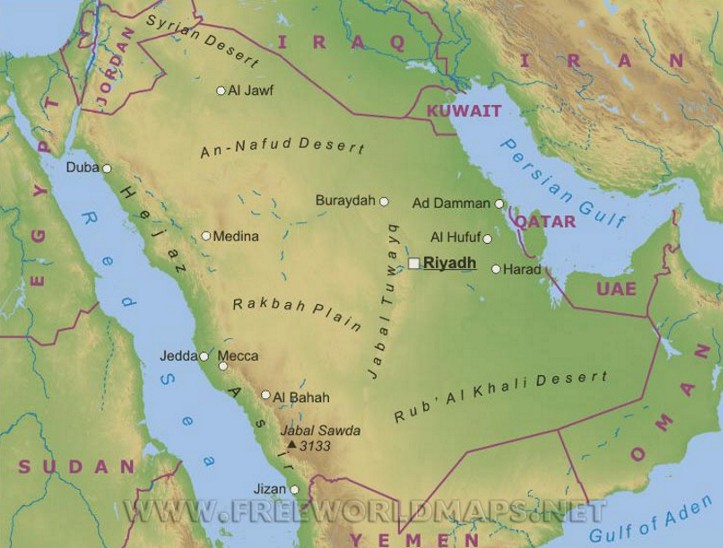 |
 |
 |
WHITE OR "ALMOST" WHITE PEOPLE COULD NOT SURVIVE IN ARABIA WITHOUT BEING COVERED FROM "HEAD-TO-TOE" WITH CLOTHING!
THE NOTION THAT THESE PEOPLE COULD BE NATIVE TO ARABIA IS A SILLY JOKE TO MOST, AND A CRUEL HOAX TO THOSE "PALE" PEOPLE SO TAUGHT.
Note: Just as modern Christian culture is far removed from ancient Hebrew culture - it is now European culture. So too is modern Arab culture far removed from original Arab culture - it is now Turkish culture. During the time of the Turkish Ottoman Empire (1299 - 1922), Islam was not known as the Arab religion, it was known as the Turkish religion.
The Thawb (Arab Robes) Emblematic of Arab culture, is not Arab at all. The original Arabs, like the Egyptians, Berbers, Mesopotamian's, Elamites/Persians: had Black skin, they did not need the Head to Toe protection from the Sun, that the Thawb affords. It is not known who invented the Thawb, but it is known that even though the Turks once ruled from Baghdad, they hated to go there because of the hot climate and burning Sunshine. Being that the original Turks were a very pale skinned Albino people who needed protection from the Sun, it is likely that they invented the Thawb.
Modern man of Turkic ethnicity in a Thawb
 |
Even with all of the above proofs and logic, we know that there are those delusional "Many" who will still insist that those Turks and Turk Mulattoes are really Arabs. In answer to those delusional people, we offer these comments:
François Auguste Ferdinand Mariette (1821 – 1881) French scholar, Archaeologist, Egyptologist, and the founder of the Egyptian Museum in Cairo.
"OUTLINES OF ANCIENT EGYPTIAN HISTORY"
TRANSLATED AND EDITED, WITH NOTES, BY MARY BRODRICK
With, an Introductory Note by William C. Winslow, D.D., D.C.L. LL.D., Vice-President of the Egypt Exploration Fund for the United States
CHARLES SCRIBNER'S SONS, NEW YORK, 1892
Page 28
Quote:
"How often do we see in Eastern monarchies and even in European states a difference of origin between the ruling class, to which the royal family belongs, and the mass of the people! We need not leave Western Asia and Egypt; we find there Turks ruling over nations to the race of which they do not belong, although they have adopted their religion. In the same way as the Turks of Baghdad, who are Finns, now reign over Semites, Turanian kings may have led into Egypt and governed a population of mixed origin where the Semitic element was prevalent. If we consider the mixing up of races which took place in Mesopotamia in remote ages, the invasions which the country had to suffer, the repeated conflicts of which it was the theatre, there is nothing extraordinary that populations coming out of this land should have presented a variety of races and origins."
“The inhabitants of this part of Arabia nearly all belong to the race of Himyar. Their complexion is almost as black as the Abyssinians,”-- Baron von Maltzan, 'Geography of Southern Arabia' (1872)
“ [the Hamida are] small chocolate colored beings, stunted and thin… with mops of bushy hair… straggling beards , vicious eyes, frowning brows … armed with scabbards slung over the shoulder and Janbiyyah daggers…” a people “of the great Hejazi tribe that has kept his blood pure for the last 13 centuries…”-- Sir Richard Burton (1879)
“The people of Dhufar are of the Qahtan tribe, the sons of Joktan mentioned in Genesis: they are of Hamitic or African rather than Arab types…”--Arnold Wilson, The Geographical Journal (1927)
“the most prosperous tribe of all the Hamitic group, possessing innumerable camels, herds of cattle and the richest frankincense country. They resemble the Bisharin tribe of the Nubian desert. Men of big bone , they have long faces long narrow jaws, noses of a refined shape long curly hair and brown skin.”--Richmond Palmer (1929)
“Mahra is the Arab name for the Bedouin tribes who are different in appearance to other Arabs, having almost beardless faces, fuzzy hair and dark pigmentation – such as the Qarra, Mahra and Harasis… Also on “…the Qarra, Mahra and Harasis with parts of other tribes. The language is derived from the language of the Sabaeans, Minaeans and Himyarites. The Mahra with other Southern Arabian peoples seem aligned to the Hamitic race of north-east Africa… The Mahra are believed to be descended from the Habasha, who colonized Ethiopia in the first millennium BC”-- David Phillips, Peoples on the Move (2001)
“European observers have made much of their physical resemblance to Somalis and Ethiopians, but there is no historical evidence of any connections.”-- E. Peterson, 'Oman’s Diverse Society: Southern Oman'
“Mr. Baldwin draws a marked distinction between the modern Mahomedan Semitic population of Arabia and their great Cushite, Hamite, or Ethiopian predecessors. The former, he says, ‘are comparatively modern in Arabia,’ they have ‘appropriated the reputation of the old race,’ and have unduly occupied the chief attention of modern scholars.”-- Charles Hardwick (1872) “Among ‘these Negroid features which may be counted normal in Arabs are the full,rather everted lips, shortness and width of nose, certain blanks in the bearded areas of the face between the lower lip and chin and on the cheeks; large, luscious,gazelle-like eyes, a dark brown complexion, and a tendency for the hair to grow in ringlets. Often the features of the more Negroid Arabs are derivatives of Dravidian India rather than inheritances of Hamitic Africa. Although the Arab of today is sharply differentiated from the Negro of Africa, yet there must have been a time when both were represented by a single ancestral stock; in no other way can the prevalence of certain Negroid features be accounted for in the natives of Arabia.”-- Henry Field, Anthropology Memoirs Volume 4 (1902)“There is a considerable mass of evidence to show that there was a very close resemblance between the proto-Egyptians and the Arabs before either became intermingled with Armenoid racial elements.”-- Elliot Smith, he Ancient Egyptians and the Origins of Civilization (1923)
“In Arabia the first inhabitants were probably a dark-skinned, shortish population intermediate, between the African Hamites and the Dravidians of India and forming a single African Asiatic belt with these.”-- Handbook of the Territories which form the Theater of Operations of the Iraq Petroleum Company Limited and its Associated Companies
In scouring for these comments, one can't help but wonder: Who in the hell could possibly believe that Pale people could be native to a Hot land with burning Sunshine and a UV index guaranteed to fry all but the darkest people. It's delusional, just delusional!
|
The Arabs
Though by the Albino Mans edict, not a part of Africa. The people of the Arabian Peninsula and Africa have freely interchanged since man first walked the Earth. All of the people of the Desert regions from the Atlantic Ocean to the Persian Gulf share a similar physical type, Black skin color, lifestyle and culture: (pale skinned people would not survive long in the Desert - Turkish Wives stayed in their tents).Some Arab History
|
Assyrian troops pursuing Arabs on camels
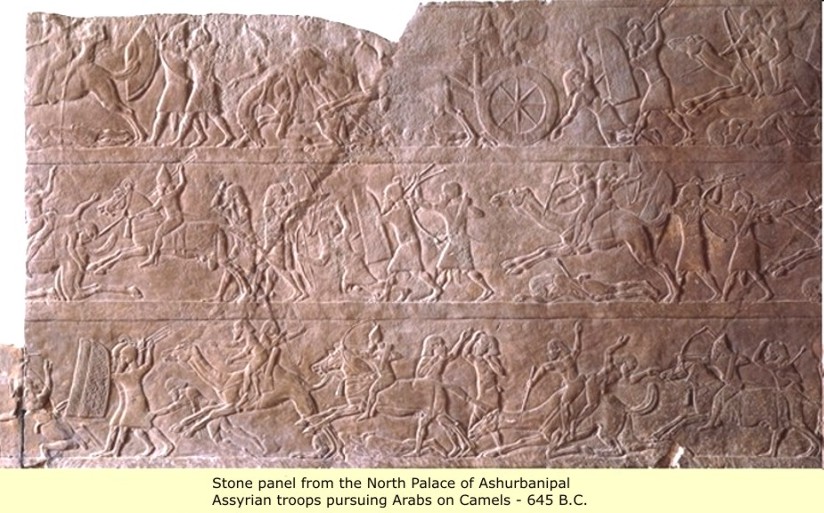 |
By the date that this panel was carved, the Arab tribes of northern Saudi Arabia, Jordan and Sinai were becoming increasingly important. They relied for long-distance travel and rapid movement on the one-humped camel or dromedary, which had been domesticated in Arabia. The Arabs first appear in Assyrian records in the ninth century B.C. Texts tell of tribes, often led by queens, living in the southern borders of the Assyrian Empire. Sometimes they guarded the borders, escorted armies in desert country, and controlled the caravan trade, especially the lucrative incense trade from Yemen.
Some tribes were also ready to take advantage of any sign of weakness in the central government. They then raided settled communities, supported rebellions, robbed caravans, and disrupted communications. The Assyrian kings launched several attacks against them without much success, since the Arabs conducted guerilla-style warfare, and were usually able to escape into the desert. Both the Assyrians and their successors, the Babylonian and Persian kings, tried to maintain peaceful relations with Arabia by threats and diplomacy. one Babylonian king, Nabonidus (555-539 B.C.) resided for several years at Teima, a centre of the incense trade in Saudi Arabia.
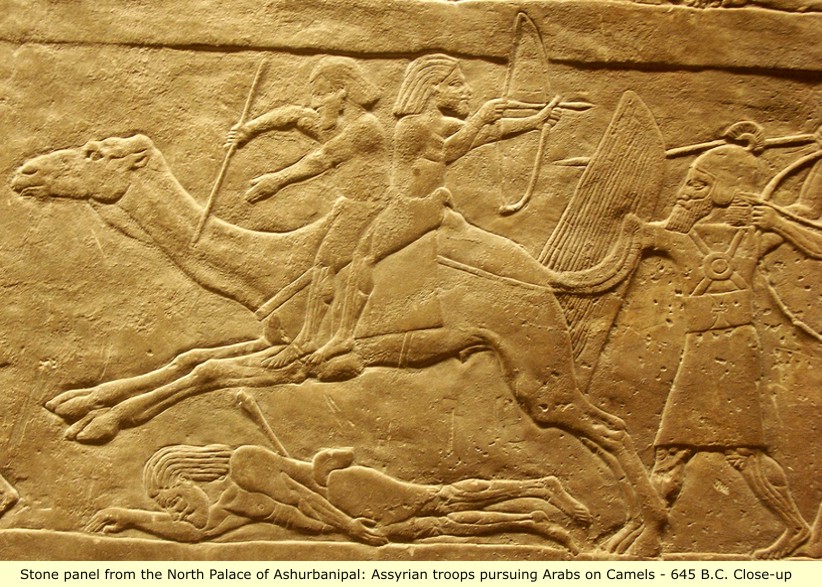 |
 |
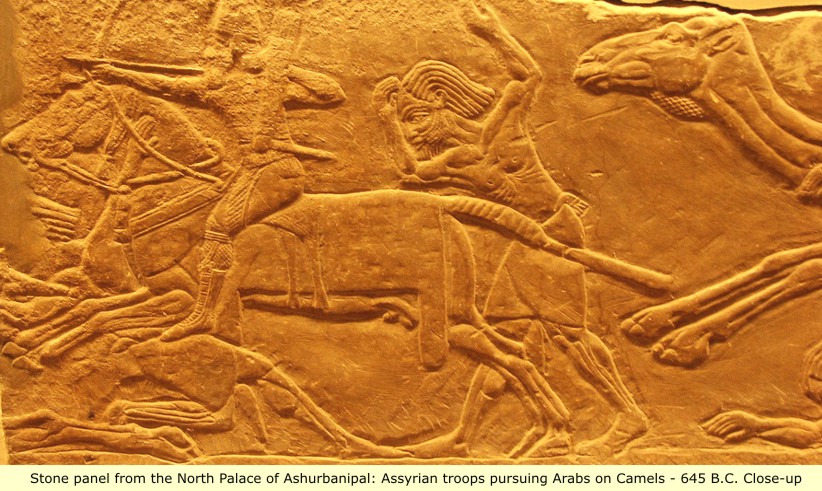 |
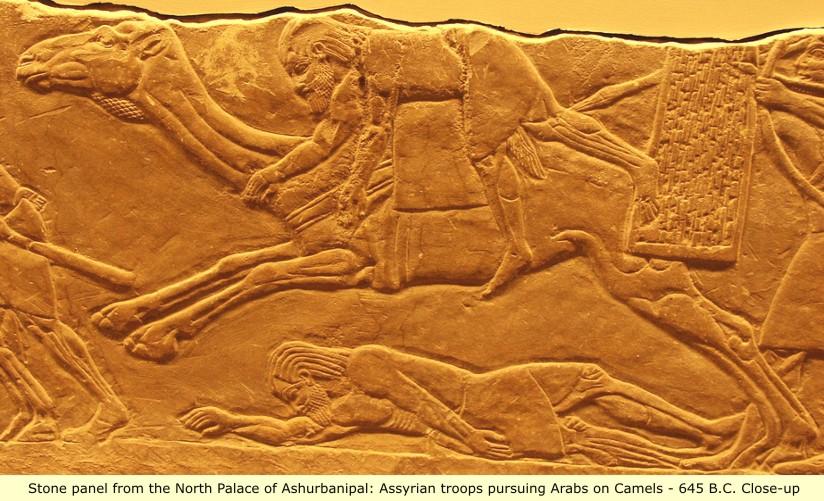 |
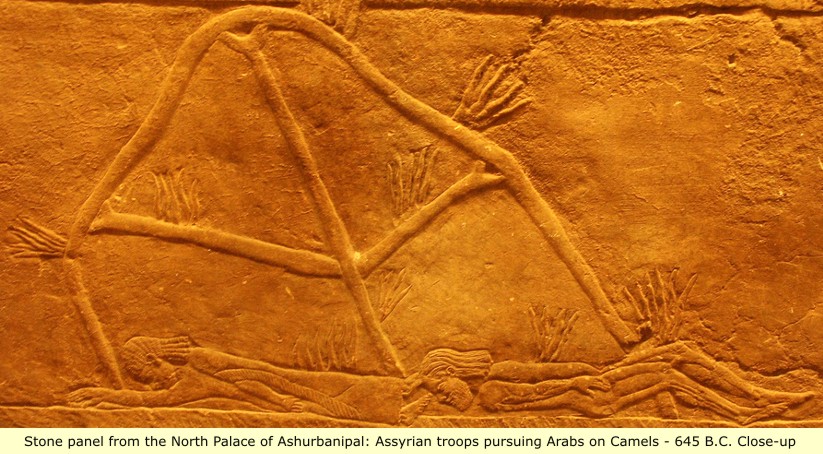 |
THE TURKS TAKE CONTROL OF ARABIA
The Turks first started usurping the Arabs when the Seljuq Turk chief Toghril Beg proclaimed himself sultan at Neyshabur in 1038. Toghril entered Baghdad in December 1055, and the Arab caliph al-Qa'im (reigned 1031–75) enthroned him, and married a Seljuq princess.
The Turks took direct control of Arabia when Sultan Mahmud II (1808-39), ordered his viceroy/governor of Egypt, the Turkic Albanian Muhammad Ali, to send an expedition to Arabia: which between 1811 and 1813 expelled the Arab Wahhabis from the Hejaz. In a further campaign (1816-18), Ibrahim Pasha, the viceroy's eldest son, defeated the Wahhabis in their homeland of Najd, and brought central Arabia under Albanian control.
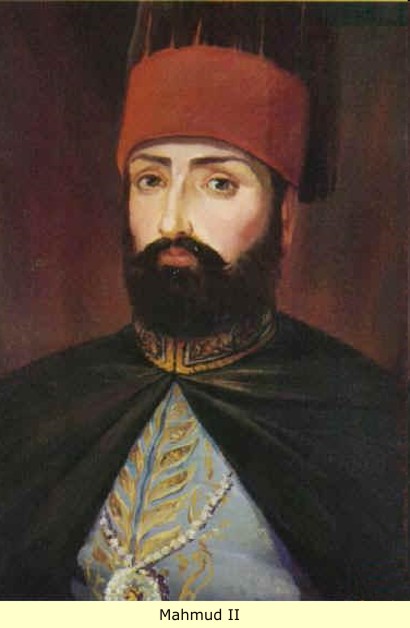 |  |
In 1820-21 Muhammad Ali sent an expedition up the Nile and conquered much of what is now the northern Sudan. By so doing, he made himself master of one of the principal channels of the slave trade, and began an African Empire that was to be expanded under his successors. The conquest of the Sudan was intended to provide recruits. But the slaves, encamped at Aswan, died wholesale, and Muhammad Ali had to look elsewhere for his troops. In 1823 he took to conscripting Egyptian peasants for the rank and file of his new army. On the other hand, the officers were mostly Turkish Ottomans, while the director of the whole enterprise, Sulayman Pasha (Colonel Sève), was a former French officer. The conscription was brutally administered. In 1882 the British once again invaded and occupied Egypt. This occupation was to last until the end of WWI. After which, Egypt became a protectorate of Britain.
After World War I
Blacks in the Turkish ruled lands, have their identities stolen by the Turks, and their Mulattoes, after the break-up of the Ottoman Empire.
As with the Berbers, Egyptians, etc. After the breakup of the Ottoman Empire after WWI, and the granting of independence to those countries after WWII, The Arabs saw their identity stolen by Whites (mainly Turks and their mulattoes) and other mixed race people.Thus Egypt is "The Arab Republic of Egypt" Syria is "The Syrian Arab Republic" Libya is "The Great Socialist People's Libyan Arab Jamahiriya" Jordan is "The Hashemite Kingdom of Jordan" (Hashemite is the Latinate version of the Arabic transliteration of Hāšimī) and traditionally refers to those belonging to the Banu Hashim Arabs, or "clan of Hashim", a clan within the larger Arab Quraish tribe. It also refers to an Arab dynasty whose original strength stemmed from the network of tribal alliances and blood loyalties in the Hejaz region of Arabia, along the Red Sea. (One can only wonder how sparsely populated Arabia could have possibly produced all of those people - what nonsense)!
 |
A study of Arabian DNA confirms historical accounts of what happened in Arabia.
Mitochondrial DNA structure in the Arabian Peninsula (This is a study of FEMALE Mt-dna)Click here for a link to the study
Results
The results showed that the Arabian Peninsula has received substantial gene flow from Africa (20%), detected by the presence of L, M1 and U6 lineages; that an 18% of the Arabian Peninsula lineages have a clear eastern provenance, mainly represented by U lineages; but also by Indian M lineages and rare M links with Central Asia, Indonesia and even Australia. However, the bulk (62%) of the Arabian lineages has a Northern source. (That's just a mealy mouthed way of saying that 60% of the people in Arabia calling themselves Arabs, are actually from somewhere else, (They are Central Asia Albinos).
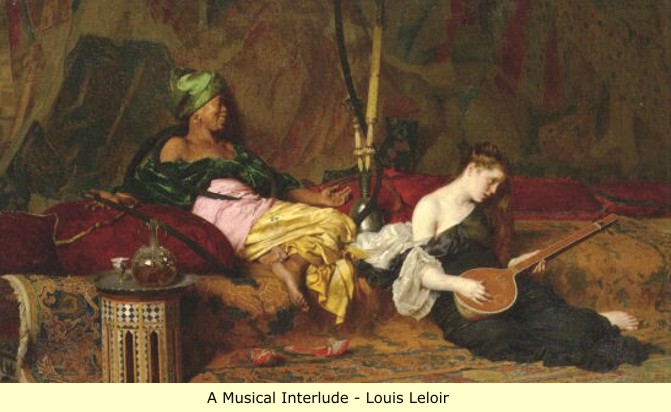 |
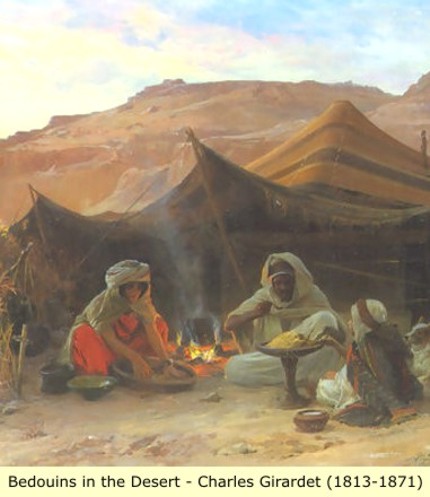 |
As indicated by the artwork above, a result of the Black Arabs fondness for sex with Albino females:
was that the old woman's type shown below, was supplanted by that of her grandchild, (the Mulatto).
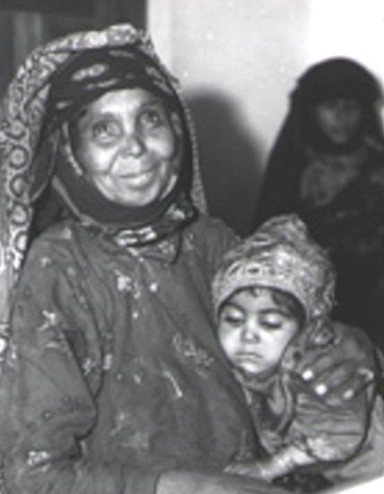 |
Genetic data and such things are fine, however it would be a dereliction not to make note that the major confusion of who are actual Arabs, is as usual, not an accident, but rather, another way the Albino people falsify and obfuscate history for the purpose of writing Blacks out of history. Take the work of Bertram Thomas - his book "Arabia Felix - Across The Empty Quarter of Arabia" was published in 1932. What is incredible about Thomas's book is that he supposedly transversed a large swath of Arabia taking pictures, and somehow managed to photograph NOT ONE SINGLE BLACK ARAB! Only Mulatto Arabs were photographed. Examples follow:
 |
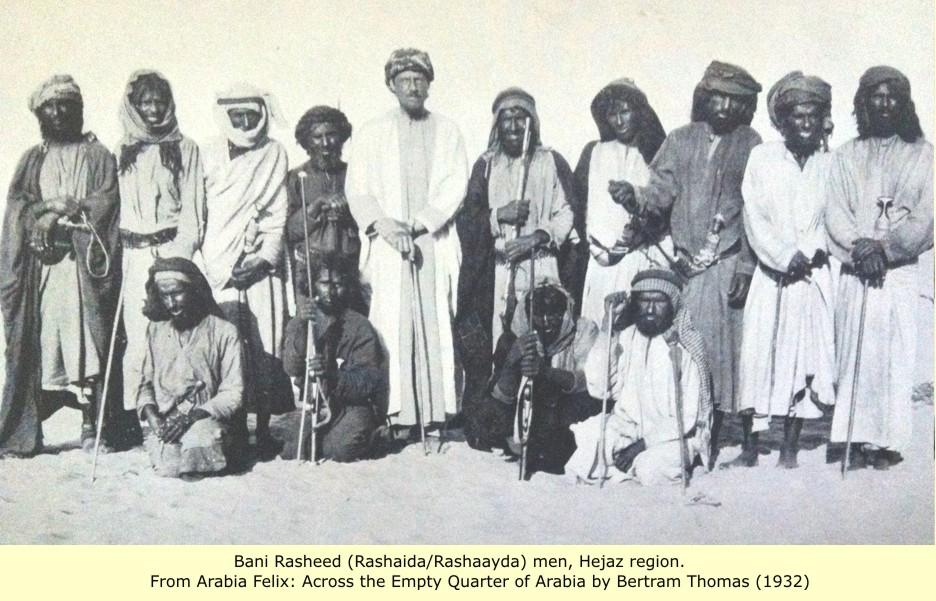 |
 |
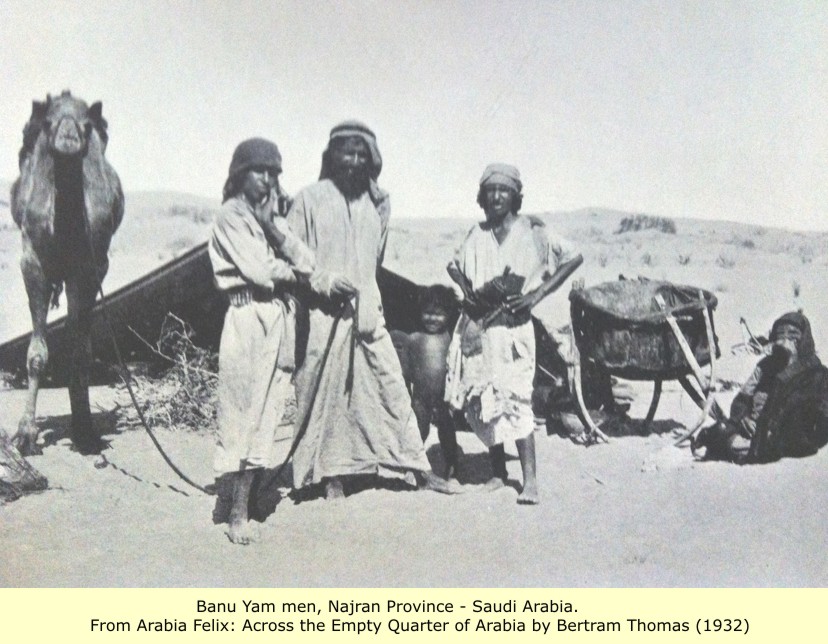 |
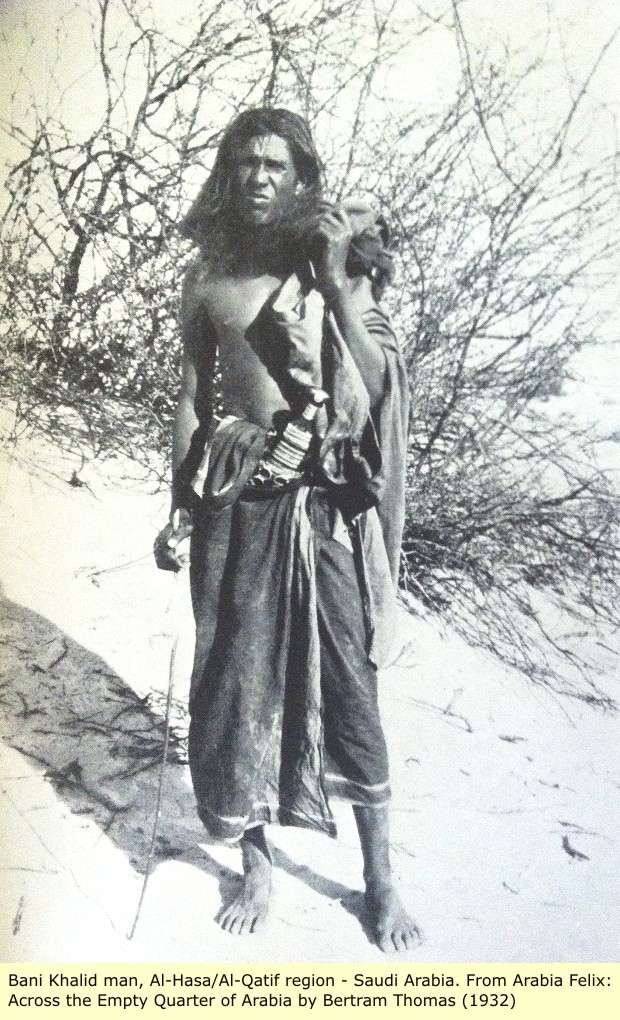 |
In October 1959 Wilfred Thesiger did the same thing: He wrote the book "Thesiger's Journeys in Arabia - First Empty Quarter Crossing 1946-7" and like Bertram Thomas, Wilfred Thesiger somehow managed to photograph NOT ONE SINGLE BLACK ARAB! Only Mulatto Arabs were photographed. Examples follow:
 |
 | 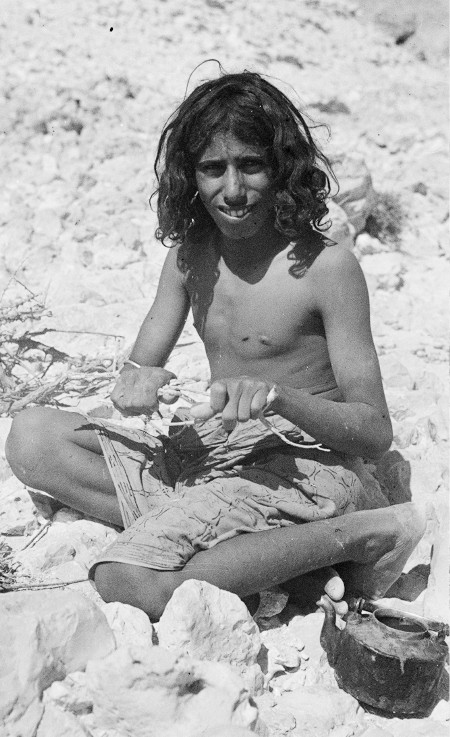 |
Is it any wonder then, why the general public would be confused as to what a "Real" Arab looks like?
In 1943 LIFE Magazine did an article on Arabs in Jerusalem, and did include a very few images of "Real" Arabs:
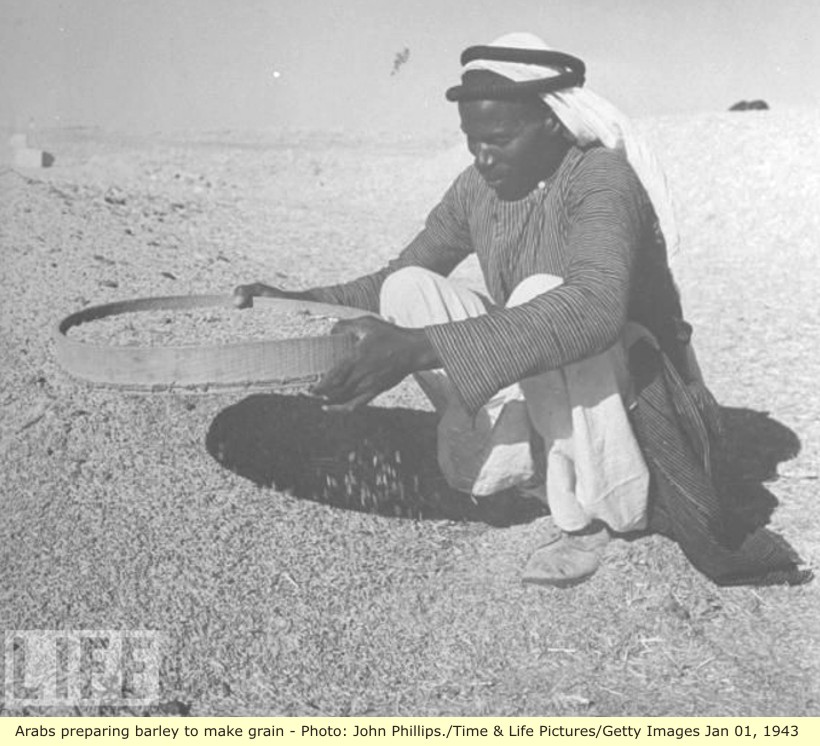 |
 |
But in typical Albino fashion, the overwhelming number of photographs were of Albinos or Mulattoes.
Some might say: well that's from the "Bad old days" of overt Racism: Not So..
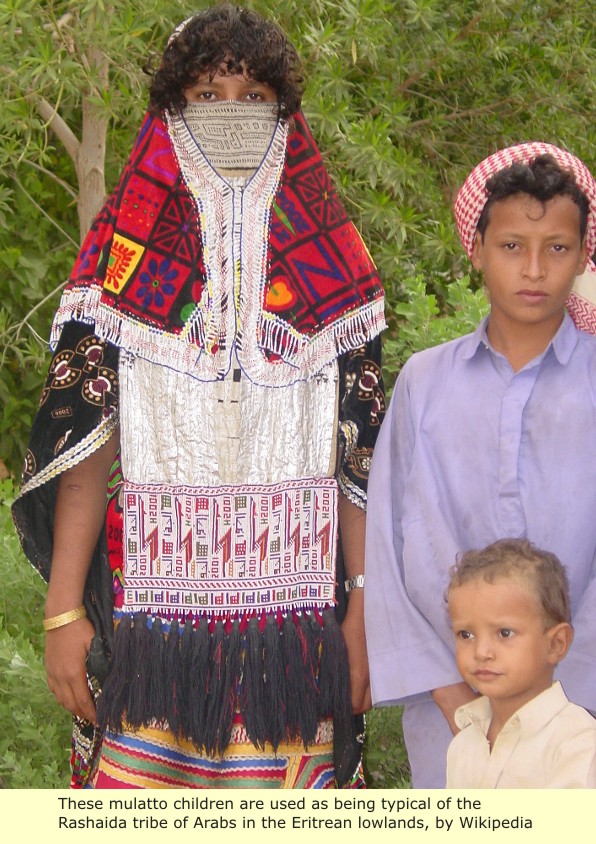 |
Wiki:
The Rashaida, (Rashaayda or Bani Rashid "Refugees") are a tribe populating Eritrea and northeast Sudan. In 1846, many Rashaida migrated from the Hejaz in present day Saudi Arabia into what is now Eritrea and northeast Sudan, after tribal warfare had broken out in their homeland. The Rashaida of Sudan and Eritrea live in close proximity with the Beja people. Large numbers of Bani Rasheed are also found on the Arabian Peninsula. The Bani Rashid are related to the Banu Abs tribe.
The Rashaida keep their traditional dress, culture, customs, camel breeds and practice of Sunni Islam. The racing camel breeds of the Rashaida tribe are prized all over Sudan and the Arabian Peninsula and fetch very high prices. The Rashaida speak Hejazi Arabic.
HERE IS WHAT THE RASHAIDA ARABS ACTUALLY LOOK LIKE!
Bani Rasheed people (Rashaida) - Camel herders at the Riyadh Camel market.
 |
 |  |  |
 |  |  |
More related Genetic data:
Y-dna Haplogroup J-P209 (This is Male dna).
In human population genetics, haplogroups define the major lineages of direct paternal (male) lines back to a shared common ancestor in Africa. Haplogroup J-P209[Phylogenetics 1] is a Y-chromosome DNA haplogroup. Its history since the Iron Age has been tied to the great events and migrations in this area and in particular to the Semitic people.J-P209 is divided into two main subclades (branches) J-M267 and J-M172.
Haplogroup J-M267
In human genetics, Y DNA haplogroup J-M267[Phylogenetics 1] is a subclade (branch) of Y-DNA haplogroup J-P209,[Phylogenetics 2] along with its sibling clade Y DNA haplogroup J-M172. Men from this lineage share a common paternal ancestor, which is demonstrated and defined by the presence of the SNP mutation referred to as M267, which was announced in (Cinnioğlu 2004). This haplogroup is found today in significant frequencies in many areas in order near the Middle East. For example it is among the most frequent haplogroups in Arabian Peninsula, and parts of the Caucasus, Sudan and the Horn of Africa. It is also found in high frequencies in parts of North Africa Jewish groups especially those with Cohen surnames. It can also be found much less commonly, but still occasionally in significant amounts, in Europe and as far east as the Central Asia.
(White people are Dravidian Albinos who migrated from India into Central Asia in search of cooler climates and less intense Sunshine). Jews (Khazars) are a Turkish tribe, quite distinct from Hebrews.
Haplogroup J-M172
In human genetics, Haplogroup J-M172[Phylogenetics 1] is a Y-chromosome haplogroup which is a subclade (branch) of haplogroup J-P209.[Phylogenetics 2] J-M172 can be classified as Greco-Anatolian, Mesopotamian and/or Caucasian and is linked to the earliest indigenous populations of Anatolia. It was carried by Bronze Age immigrants to Europe, and ultimately descends from the Cro-Magnon population (IJ-M429 Y-DNA) that emerged in Southwest Asia around 35,000 years ago (Sengupta 2006).
In modern Saudi Arabia, the original Arabs (the Black ones) have been relegated to the deserts and the tribal areas in the south at the Yemeni boarder. The preponderance of haplogroup "J" in the Saudi Arabian DNA, suggests that these areas were purposefully avoided or severely under-represented when doing the DNA survey. For it is extremely unlikely that these Qahtan and Wayla tribesmen from the Najran area, close to the border with Yemen, would be of haplogroup "J".
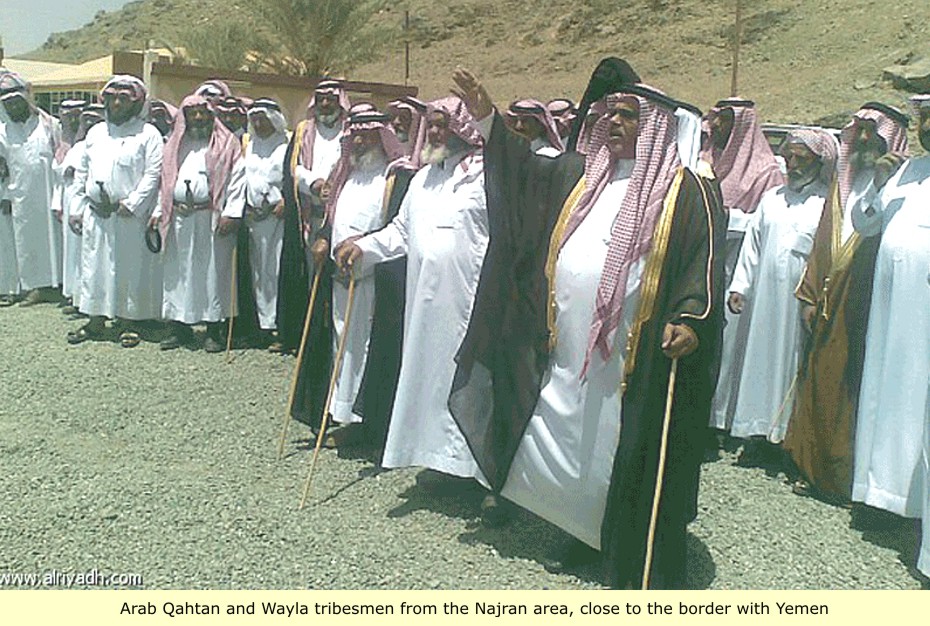 |
 |
 |
Saba - Yemen
Encyclopædia Britannica
Sabaʾ, biblical Sheba, kingdom in pre-Islamic southwestern Arabia, frequently mentioned in the Bible (notably in the story of King Solomon and the Queen of Sheba) and variously cited by ancient Assyrian, Greek, and Roman writers from about the 8th century bc to about the 5th century ad. Its capital, at least in the middle period, was Maʾrib, which lies 75 miles (120 km) east of present-day Sanaa, in Yemen. A second major city was Ṣirwāḥ.
The Sabaeans were a Semitic people who, at an unknown date, entered southern Arabia from the north, imposing their Semitic culture on an aboriginal population. Excavations in central Yemen suggest that the Sabaean civilization began as early as the 10th–12th century bc. By the 7th–5th century bc, besides “kings of Sabaʾ ” there were individuals styling themselves “mukarribs of Sabaʾ,” who apparently either were high priest–princes or exercised some function parallel to the kingly function. This middle period was characterized above all by a tremendous outburst of building activity, principally at Maʾrib and Ṣirwāḥ, and most of the great temples and monuments, including the great Maʾrib Dam, on which Sabaean agricultural prosperity depended, date back to this period. Further, there was an ever-shifting pattern of alliances and wars between Sabaʾ and other peoples of southwestern Arabia—not only the important kingdoms of Qatabān and Ḥaḍramawt but also a number of lesser but still independent kingdoms and city-states.
Sabaʾ was rich in spices and agricultural products and carried on a wealth of trade by overland caravan and by sea. For centuries it controlled Bāb el-Mandeb, the straits leading into the Red Sea, and it established many colonies on the African shores. That Abyssinia (Ethiopia) was peopled from South Arabia is proved linguistically; but the difference between the Sabaean and Ethiopian languages is such as to imply that the settlement was very early and that there were many centuries of separation, during which the Abyssinians were exposed to foreign influences. New colonies, however, seem occasionally to have followed, and some parts of the African coast were under the suzerainty of the Sabaean kings as late as the 1st century bc.
Toward the end of the 3rd century ad, a powerful king named Shamir Yuharʿish (who seems incidentally to be the first really historical personage whose fame has survived in the Islamic traditions) assumed the title “king of Sabaʾ and the Dhū Raydān and of Ḥaḍramawt and Yamanāt.” By this time, therefore, the political independence of Ḥaḍramawt had succumbed to Sabaʾ, which had thus become the controlling power in all southwestern Arabia. In the mid-4th century ad, it underwent a temporary eclipse, for the title of “king of Sabaʾ and the Dhū Raydān” was then claimed by the king of Aksum on the east African coast. At the end of the 4th century, southern Arabia was again independent under a “king of Sabaʾ and the Dhū Raydān and Ḥaḍramawt and Yamanāt.” But within two centuries the Sabaeans would disappear as they were successively overrun by Persian adventurers and by the Muslim Arabs.
"Real" Arabs
 |
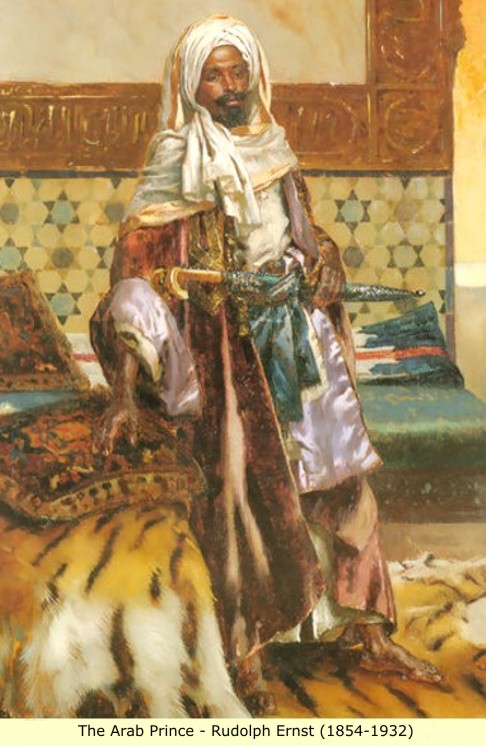

 |
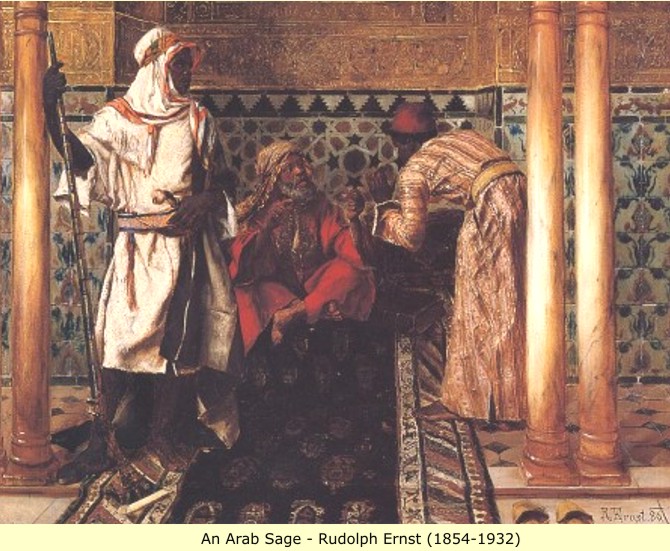 |
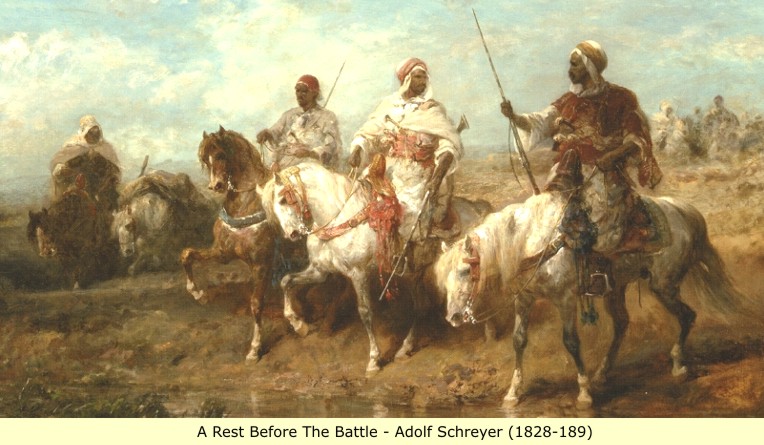 |
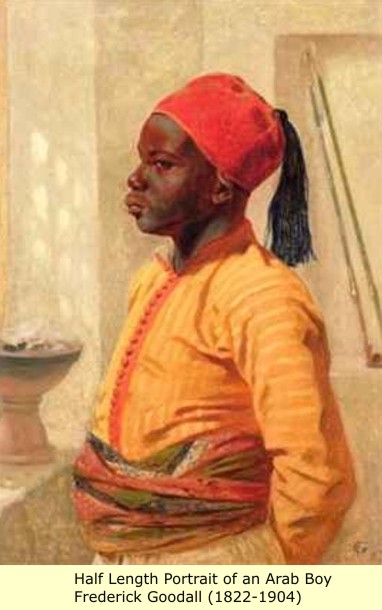
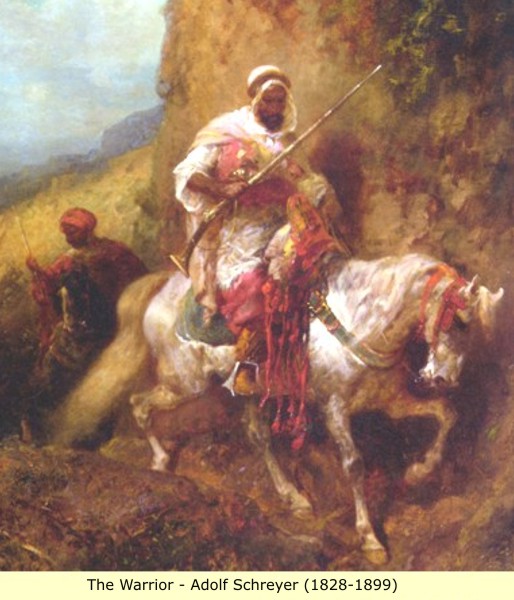
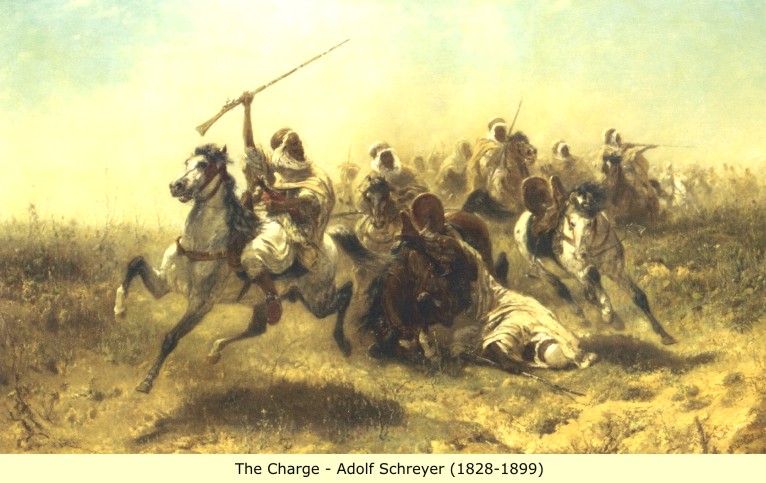 |
The Arabs and Moors were very fond of Turkish women, they kept their Harems well stocked with them.  |
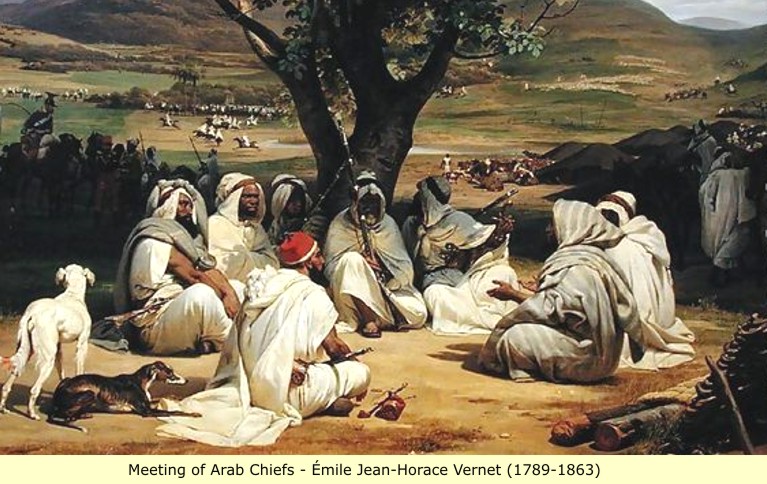 |
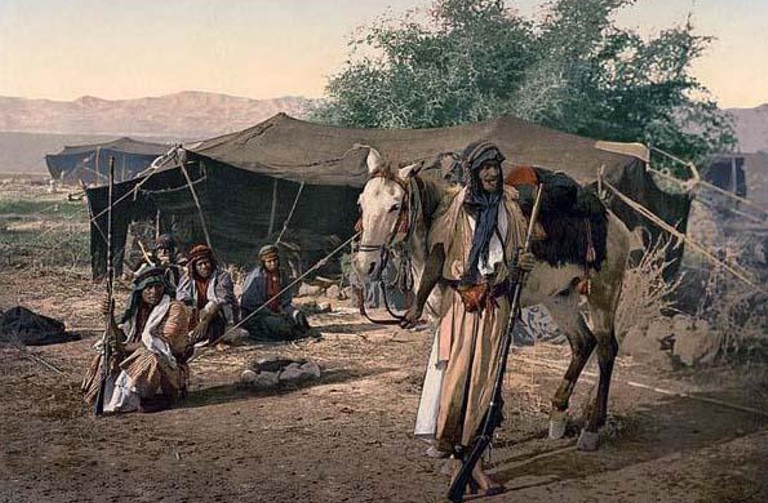 |
OLD PICTURES OF ARABS
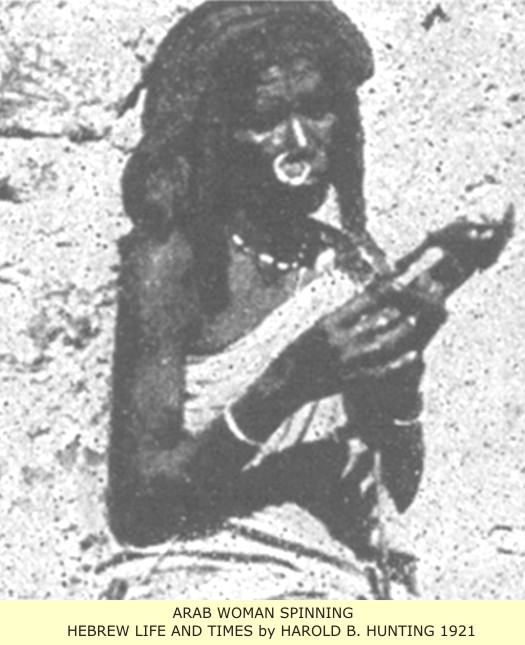 | 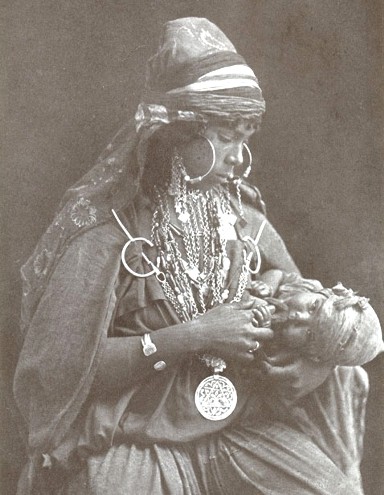 |
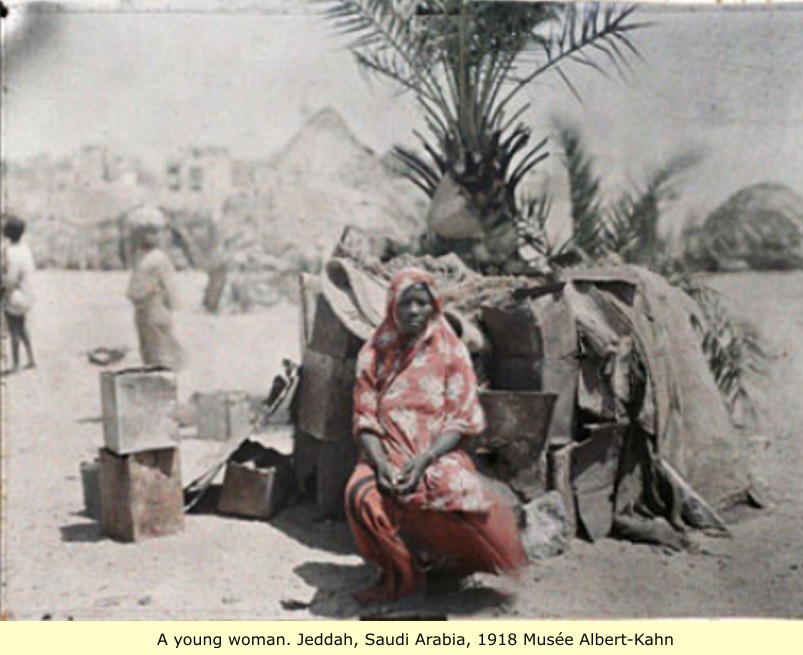 |
 | 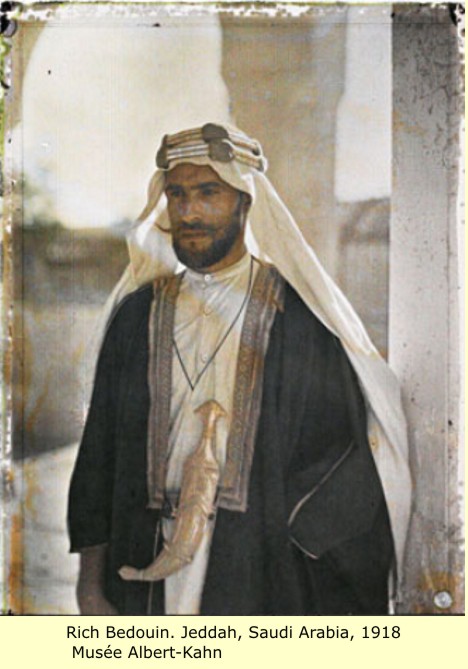 |
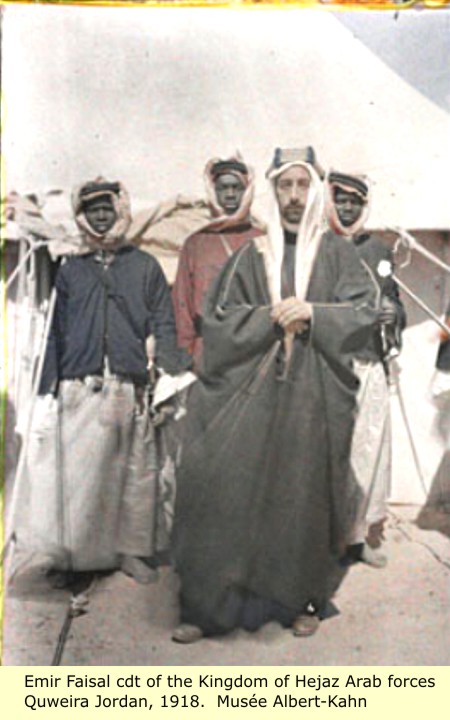 | 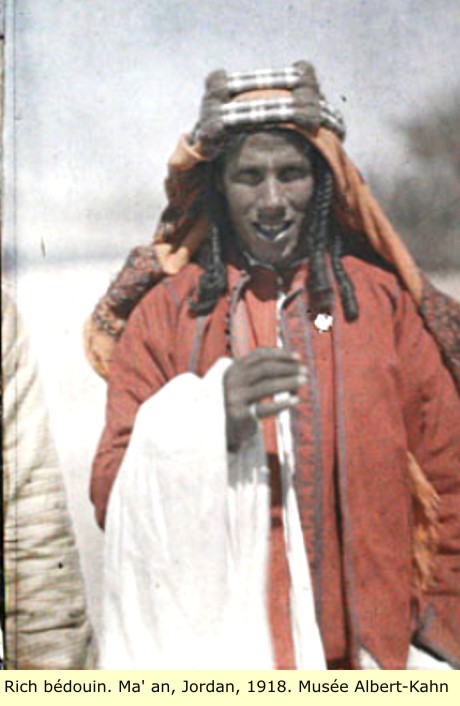 |
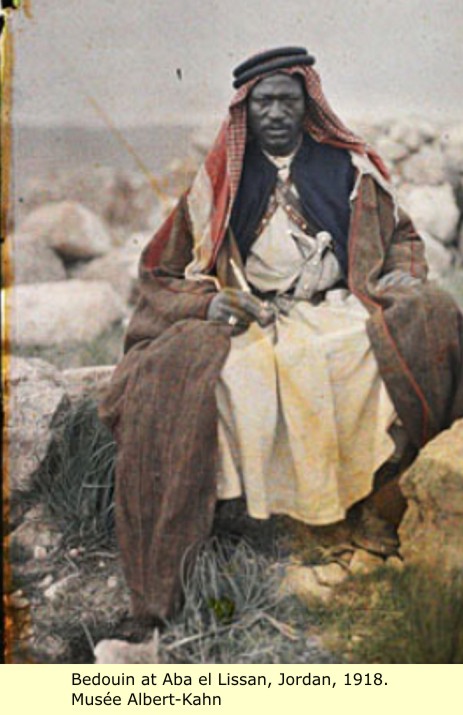 |
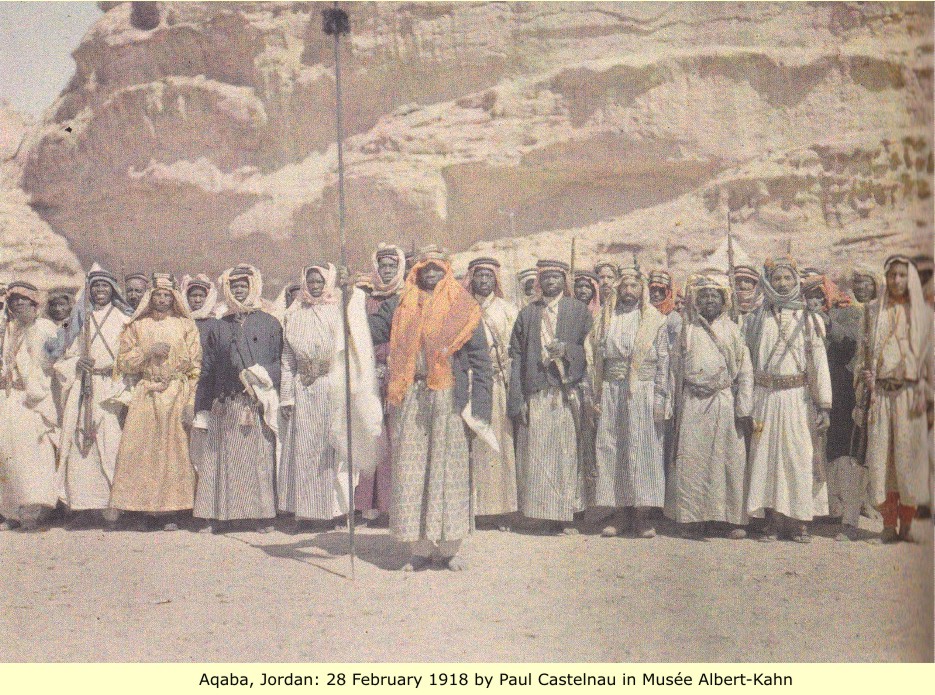 |
MORE MODERN ARABS
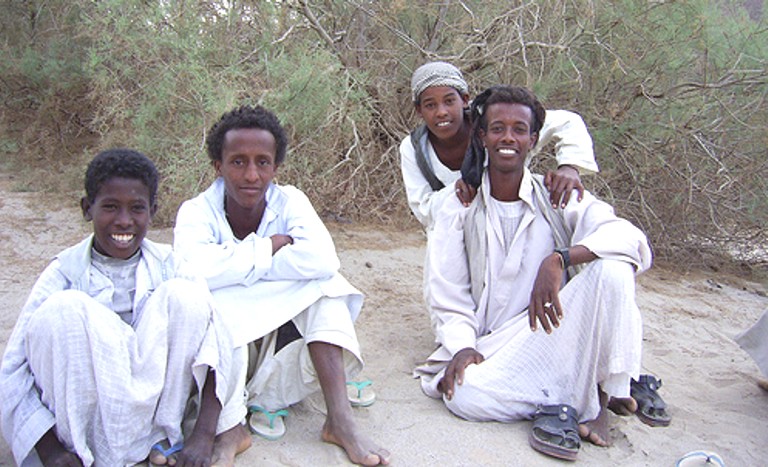 |
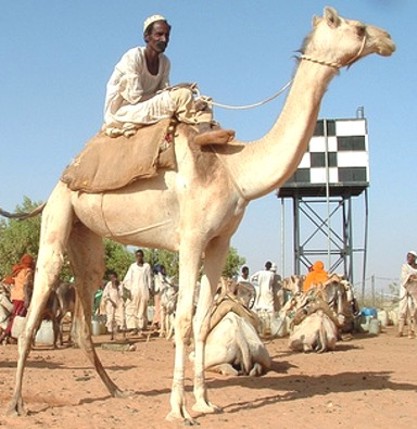

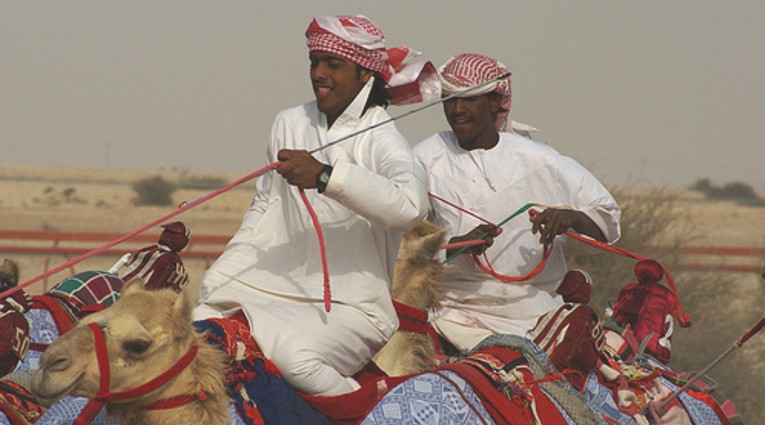 |
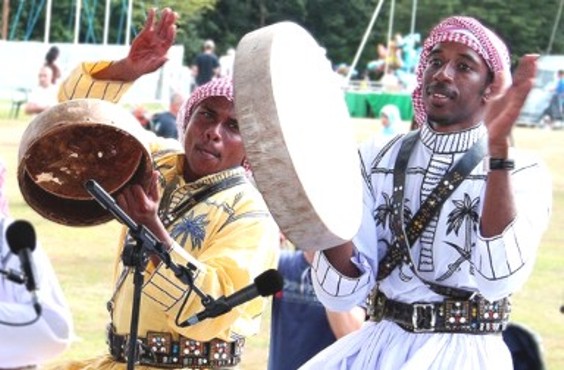

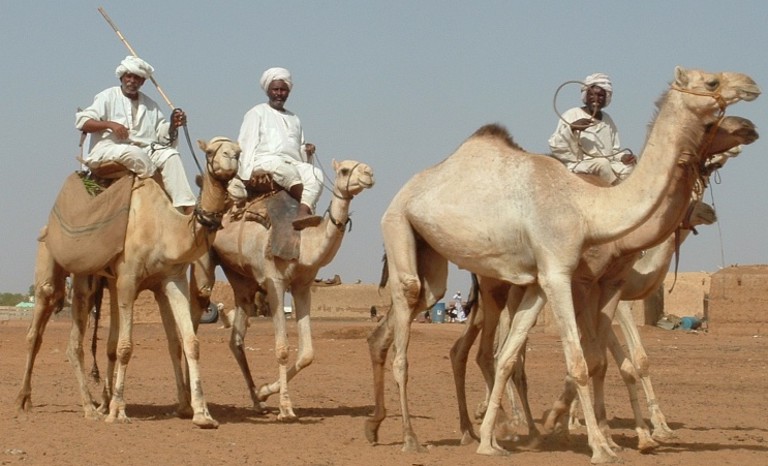 |
The original Turks were a Central Asian Albino people, just like the Germanics and Slavs now in Europe and Russia: And they were just as Pale as the Germanics and Slavs too. However, admixture with the native Blacks of Anatolia, North Africa, The Middle-East, and Arabia, has significantly changed the Turk phenotype.
 |
(The Qajar dynasty is a Persianized Iranian royal family of Turkic origin, which ruled Persia (Iran) from 1785 to 1925. The Qajar family took full control of Iran in 1794 after deposing Lotf 'Ali Khan, the last of the Zand dynasty rulers - who were also foreigners).
Today - with the help of European Albino media, the Turk mulattoes have completely usurped the Arab identity, along with that of the original North Africans and Middle-Easterns. Today - THIS is what an Arab, Berber, Egyptian, Babylonian, Mesopotamian, Persian, etc. looks like.
Why are the same looking people Everywhere?
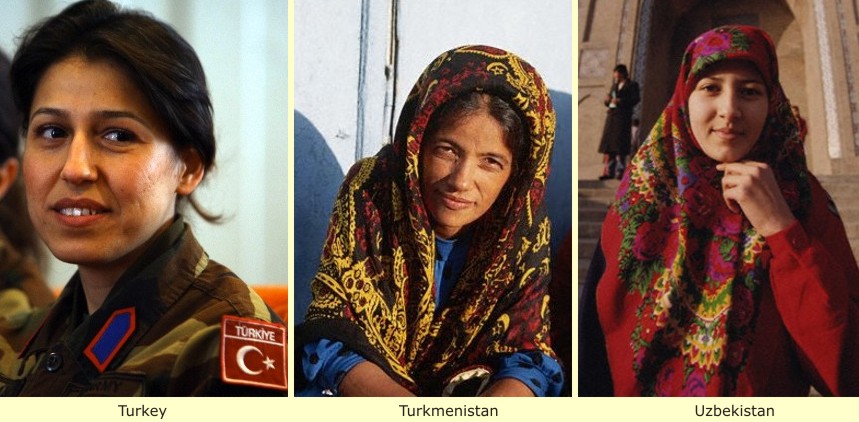 |
Turk Mulattoes and Quadroons
THE "NEW" ARABS
 |
 |
 |
 |
 |
 |  |
 |
Ancient man crossed Arabia to settle the rest of the World
LiveScience
Arabian Artifacts May Rewrite 'Out of Africa' Theory
Charles Choi, LiveScience Contributor, November 30, 2011
Newfound stone artifacts suggest humankind left Africa traveling through the Arabian Peninsula instead of hugging its coasts, as long thought, researchers say. Modern humans first arose about 200,000 years ago in Africa. When and how our lineage then dispersed has long proven controversial, but geneticists have suggested this exodus started between 40,000 and 70,000 years ago. The currently accepted theory is that the exodus from Africa traced Arabia's shores, rather than passing through its now-arid interior.However, stone artifacts at least 100,000 years old from the Arabian Desert, revealed in January 2011, hinted that modern humans might have begun our march across the globe earlier than once suspected. Now, more-than-100 newly discovered sites in the Sultanate of Oman apparently confirm that modern humans left Africa through Arabia long before genetic evidence suggests. Oddly, these sites are located far inland, away from the coasts."After a decade of searching in southern Arabia for some clue that might help us understand early human expansion, at long last we've found the smoking gun of their exit from Africa," said lead researcher Jeffrey Rose, a paleolithic archaeologist at the University of Birmingham in England. "What makes this so exciting is that the answer is a scenario almost never considered."
 |
The international team of archaeologists and geologists made their discovery in the Dhofar Mountains of southern Oman, nestled in the southeastern corner of the Arabian Peninsula. "The coastal expansion hypothesis looks reasonable on paper, but there is simply no archaeological evidence to back it up," said researcher Anthony Marks of Southern Methodist University, referring to the fact that an exodus by the coast, where one has access to resources such as seafood, might make more sense than tramping across the desert.
On the last day of the research team's 2010 field season, the scientists went to the final place on their list, a site on a hot, windy, dry plateau near a river channel that was strewn with stone artifacts. Such artifacts are common in Arabia, but until now the ones seen were usually relatively young in age. Upon closer examination, Rose recalled asking, "Oh my God, these are Nubians — what the heck are these doing here?" The 100-to-200 artifacts they found there were of a style dubbed Nubian Middle Stone Age, well-known throughout the Nile Valley, where they date back about 74,000-to-128,000 years. Scientists think ancient craftsmen would have shaped the artifacts by striking flakes off flint, leading to distinctive triangular pieces. This is the first time such artifacts have been found outside of Africa. Subsequent field work turned up dozens of sites with similar artifacts. Using a technique known as optically stimulated luminescence dating, which measures the minute amount of light long-buried objects can emit, to see how long they have been interred, the researchers estimate the artifacts are about 106,000 years old, exactly what one might expect from Nubian Middle Stone Age artifacts and far earlier than conventional dates for the exodus from Africa.
Finding so much evidence of life in what is now a relatively barren desert supports the importance of field work, according to the researchers. "Here we have an example of the disconnect between theoretical models versus real evidence on the ground," Marks said. However, when these artifacts were made, instead of being desolate, Arabia was very wet, with copious rain falling across the peninsula, transforming its barren deserts to fertile, sprawling grasslands with lots of animals to hunt, the researchers explained. "For a while, South Arabia became a verdant paradise rich in resources — large game, plentiful fresh water, and high-quality flint with which to make stone tools," Rose said.
Instead of hugging the coast, early modern humans might therefore have spread from Africa into Arabia along river networks that would've acted like today's highways, researchers suggested. There would have been plenty of large game present, such as gazelles, antelopes and ibexes, which would have been appealing to early modern humans used to hunting on the savannas of Africa.
 |
| Home | Back |
-----------------------
Glorious Persia-
This section is dedicated to all the brave Persian women that were wisely running the country for thousands of years. In Persia, women enjoyed a level of gender equality unmatched even to this day! Female emperors ruled over the many dynasties of the Persian Empire. Many ancient Persian cities and states were ruled by women and had their army totally under control of female commanders. The significant role of women in Ancient Persia both horrified and fascinated the ancient Greek and Roman male-dominated societies. Women in Persia were very honored and revered, they often had important positions in the Courthouse, Ministries, Military, State and Treasury Department, and other official administrations. Women were treated like Goddesses esteemed as mothers of creation before the imposition of the dark, backward, and pernicious Abrahamic ideologies (Judaism, Christianity, and especially Islam) after the barbaric Arab invasion upon Persia which destroyed our style of Humane Federalism, Bill of Rights, Equalism, Freedom of speech and Freedom of religion and replaced those factors with central brutal government, prejudice and slavery. Recent works on the role of women in ancient Persia show great participation by women in all facets of life, indicating not only their autonomy and independence, but the existence of an equal social system which accepted the authority and independence of women. The fortification tablets at the Ruins of Persepolis also reveals that men and women were represented in identical professions and that they received equal payments as skilled laborers and that gender was not a criterion at all (unlike our modern world). New mothers and pregnant women even received wages far above those of their male co-workers as gratitude. There is much evidence that the principles of Zoroastrianism lay the core foundation to the first Declaration of Human Rights in the Persian Empire set by Cyrus the Great since the rulers of Persia were Zoroastrians and relatively liberal and progressive.
It is essential for Women to know and understand their glorious history of the past, because without it, they will not be able to plant their place in the future. Our so called civilized modern world still has a long way to go in terms of gender equality. Freedom & Equality does not come free and no one will ever deliver it to us in a silver platter. We must build relationships that are unimpeded by gender-based distinctions and discrimination.
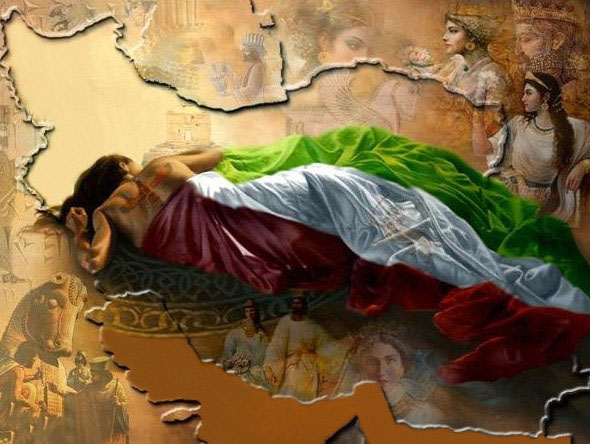
Most scholars today agree that women internationally step by step became second rate citizens and lost all their power, autonomy, independence, rights and consistently assigned a passive role in the society as soon as Abrahamic religions (Judaism, Christianity, and especially Islam) became widespread. The gendering of those religions is oppressively male  . The creator in Genesis is presented as an Old Male Sovereign Outsider who relate to the world by way of command. It is a male story of power, a story of hierarchical command and control. Religious discrimination against women is still alive and thriving! The texts of the Torah, Bible and Quran preach discrimination against women, degradation and subjugation of women, and even violence against women! They teach that women are not only inferior, but also must obey men, because “God” tells us that men are their masters (justifying all manner of religion-justified nastiness directed against them). In other words, the texts of these so-called “holy books” systematically ensure a second-class status for women
. The creator in Genesis is presented as an Old Male Sovereign Outsider who relate to the world by way of command. It is a male story of power, a story of hierarchical command and control. Religious discrimination against women is still alive and thriving! The texts of the Torah, Bible and Quran preach discrimination against women, degradation and subjugation of women, and even violence against women! They teach that women are not only inferior, but also must obey men, because “God” tells us that men are their masters (justifying all manner of religion-justified nastiness directed against them). In other words, the texts of these so-called “holy books” systematically ensure a second-class status for women  . (Mothers of Creation, who make up a little over half of the world’s population).
. (Mothers of Creation, who make up a little over half of the world’s population).
Queen Mandana is a central character in legends describing the birth of Cyrus the great. According to ancient greek historian Herodotus, after the birth of Cyrus the Great, King Astyages had a strange dream that his “Magi” (Court Magician) interpreted as a sign that his grandson would eventually overthrow him. He then ordered his steward Harpagus to kill the infant. Harpagus, morally unable to kill a newborn hid the child, who was none other than Cyrus himself (Cyrus the Great) with a shepherd named Mitridates. Cyrus grew up without knowing that he came from a Royal Bloodline. According to this legend, Cyrus would eventually defy his grandfather, King Astyages, leading to a great war between them; as the dream had forecast. There are references to Mandana’s death as 559 B.C.E. in the history books. King Darius the Great named his daughter “Mandana“ after her.

The Declaration of Human Rights written by Cyrus the Great has been hailed as the first charter of human rights, predating the Magna Carta by nearly two millenniums (~1700 years) and in 1971 the United Nations was published translation of it in all the official U.N. languages. It is now kept in the British Museum and it is no exaggeration to say that it is one of the most precious historical records of the world. Also a replica of the Cyrus Charter of Human Rights is kept at the United Nations Headquarters in New York.
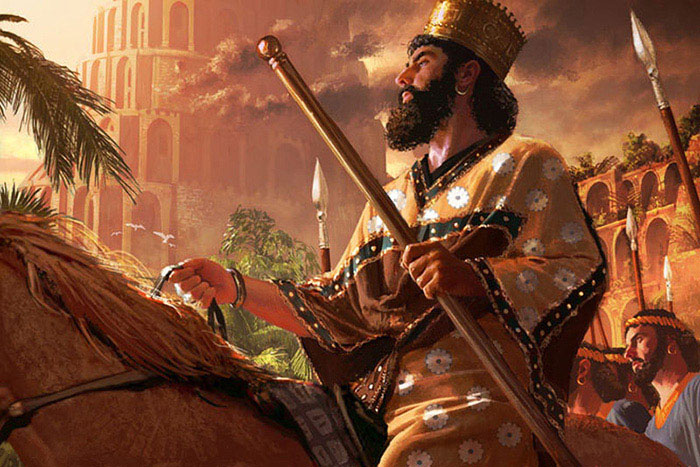


The elite force were known as “The Immortals” because they were kept constantly at a strength of exactly 10,000 men, every killed or seriously wounded member was immediately replaced. To insure loyalty, the original members of this “immortal” fighting machine were Persians by bloodline and trained from early childhood (age 7+). Not everyone could become one of the 10,000 since the training was very rigorous and hard both physically and psychologically. They also followed a strict adherence to the religion of the prophet Zarathustra and his teachings in order to respect and value life. “The Immortals” were mainly used during the last stages of each battle as reinforcement by the order of the King of Kings to shock the enemies strategically.
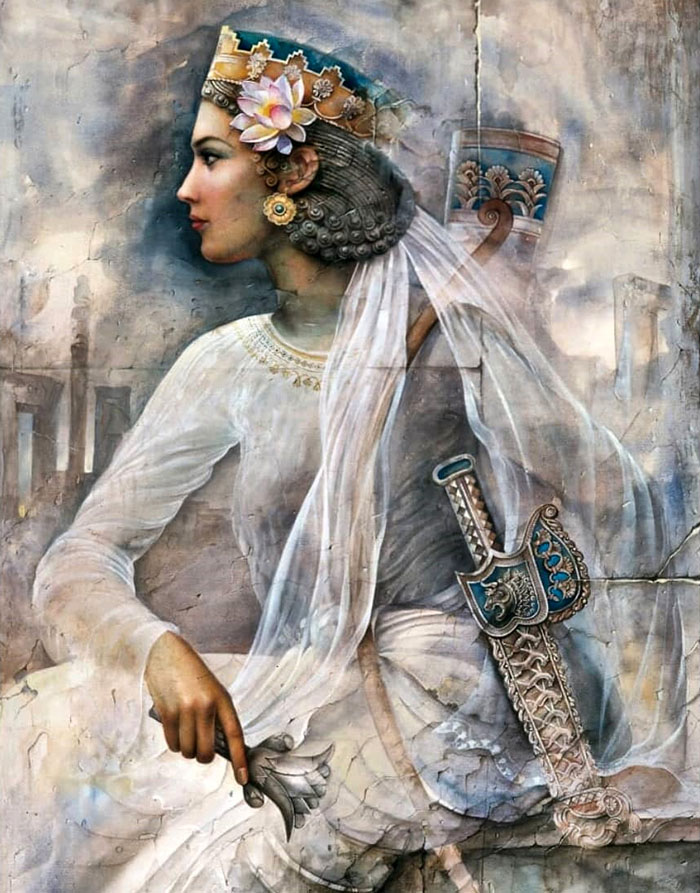
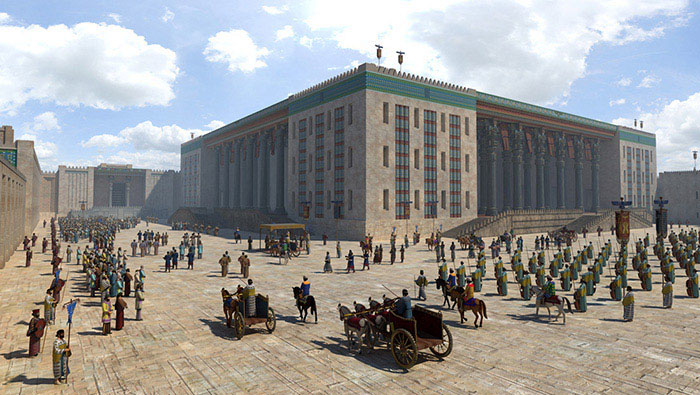
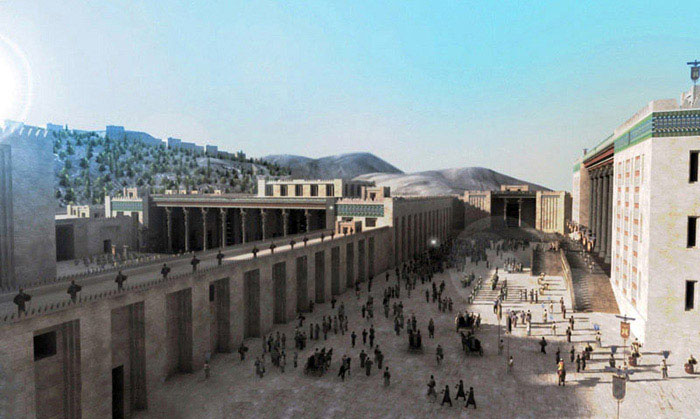
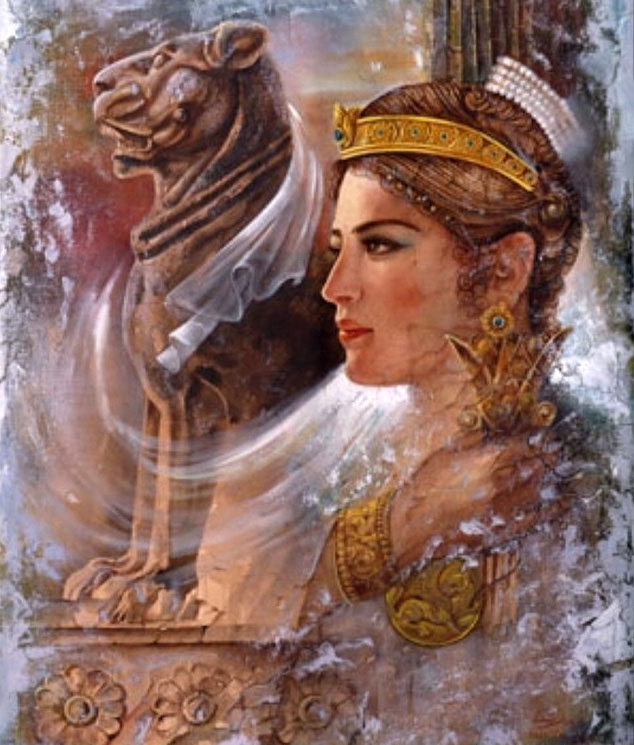
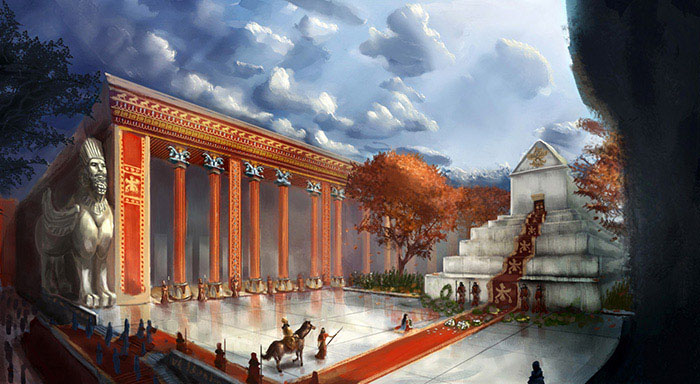
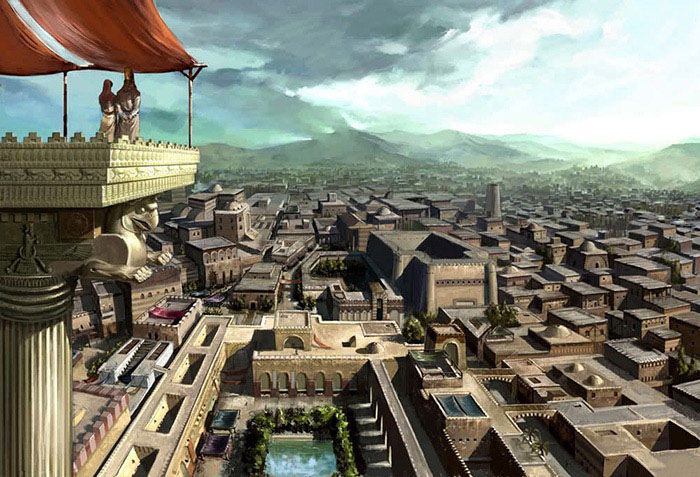


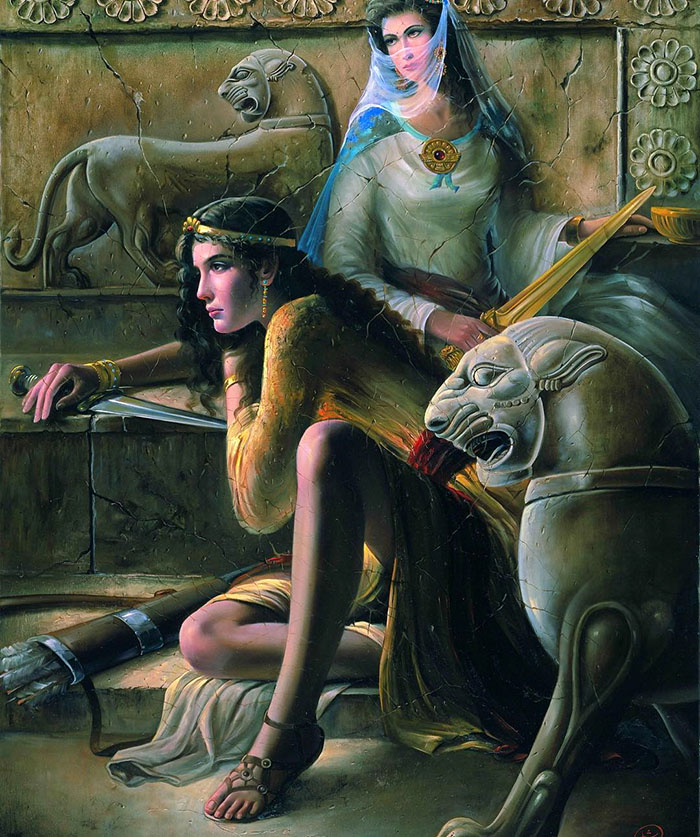
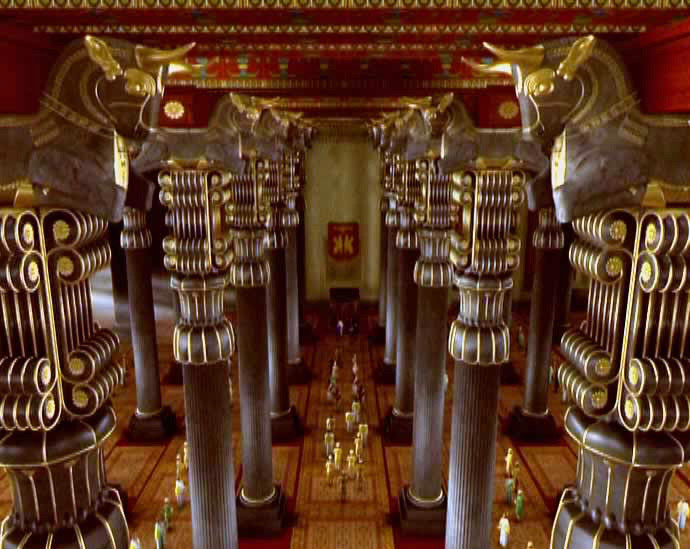
Click here to read the Testament of Darius the Great to his son and successor Emperor Xerxes the Great (Kheshayar Shah).
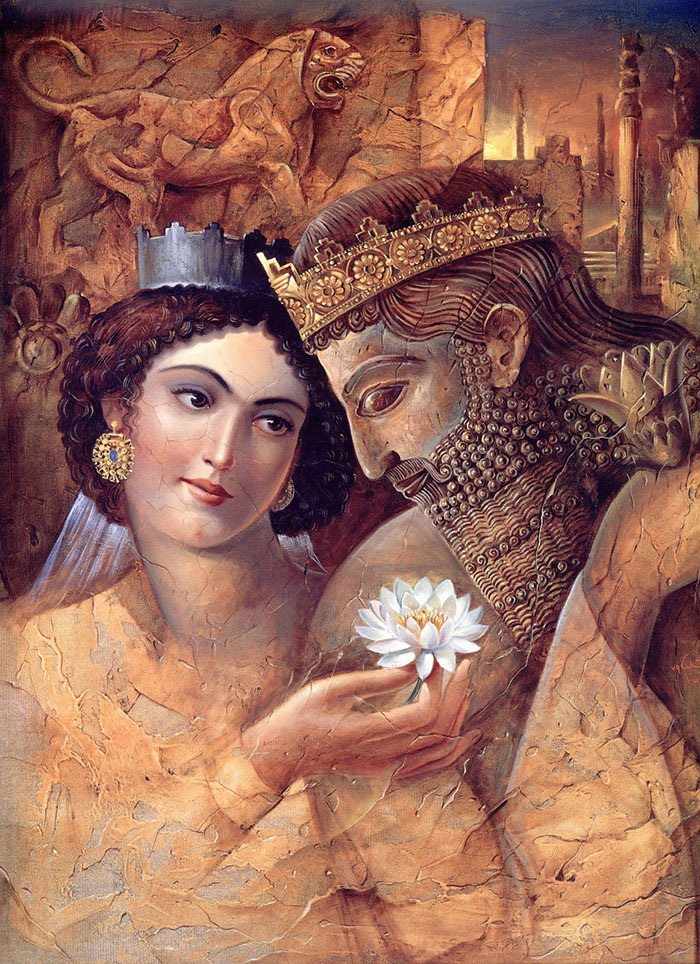
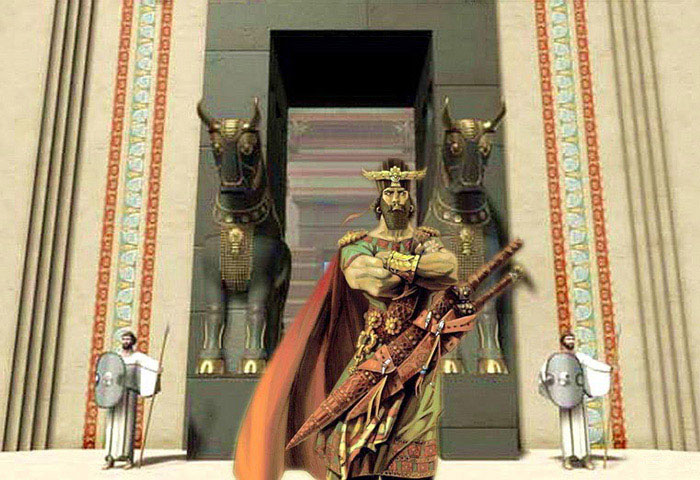
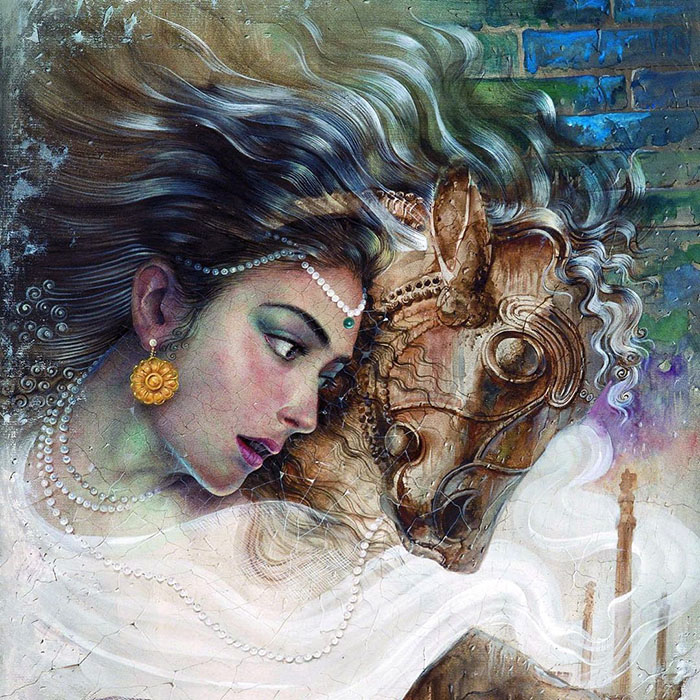
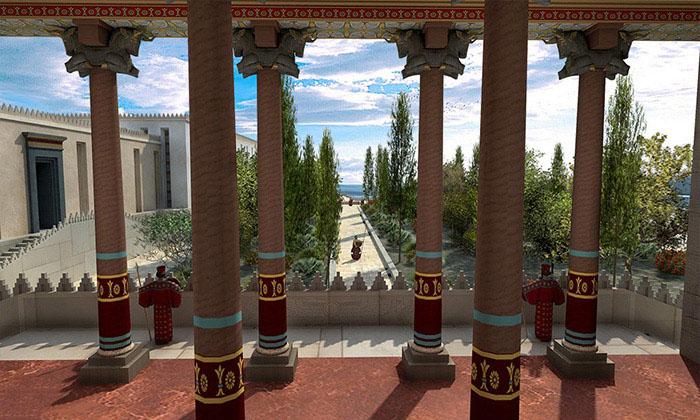
Worth to mention is that over a half millennium after Irdabama, in Europe, Roman women were not allowed to own their very own business and land. They were not allowed even to make suggestions. Also, women belonging to wealthy families didn’t work. Work was reserved thus for slaves and for the lower classes according to Roman and Greek historians. In the ancient Greece, women were considered to be inferior species. And the situation became worse each century as Abrahamic religions (Judaism, Christianity, and Islam) became widespread.


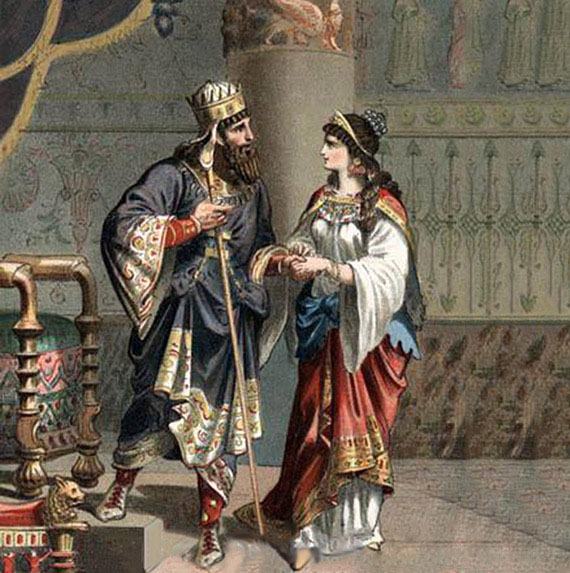
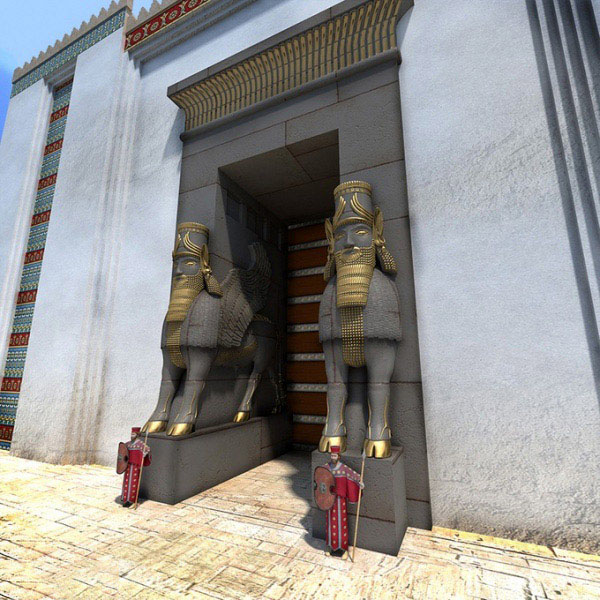
When the Persian King Xerxes went to war against Greece in 480 B.C.E, Artemisia led her powerful ships and helped Xerxes defeat the Greeks in the beginning phases of naval battle of Salamis. Ancient Greek historian Herodotus writes, apparently quite embarassed: “It seems to me a marvel that she - a woman - should have taken part in the campaign against Greece.” The Athenians resented women in arms, says Herodotus. The Greeks offered a reward of 10,000 drachmas for capturing Artemisia’s head, but no one succeeded in winning the prize. Understand that back then Persia was the sole superpower of the globe and Greece consisted of tens of separated and scattered city-states, each played their own tunes and they were busy fighting each other all the time. Some of these city-states were pro Persia, some were anti Persia, some were neutral and some were even parts of Persia as protectorates! Admiral Artemisia became a living legend and a role model for all the women in the Empire and the known civilized World.The name “Artemisia” means: “The great speaker of truth.”


...History is unfourtunatley always written by the victors and the usual Greek anachronism often corrupts historical facts about Persia.
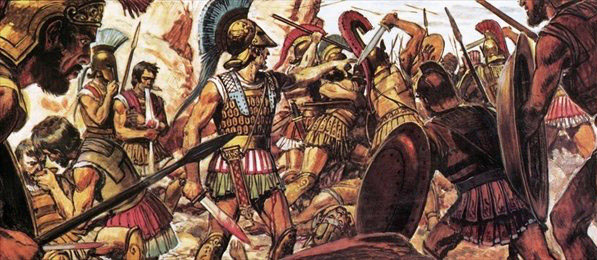
What Persia did not achieve through war, it obtained through diplomacy.
Yet Xerxes never married her, funny how Xerxes later ended up marrying Esther his Jewish Princess! Yes, no matter how much this great love affair between Xerxes and Artemisia dragged on, yet they never got married! It was diny for Esther to come along in the years ahead and to steal Xerxes’ heart again! Grand Admiral Artemisia wanted a very high position and command in Persian CourtHouse to establish her absolute power and authority in the Persian Achaemenid Court. Well, Persian Empire being the only Super Power in the known world back then, she wanted to be an important part of it! Artemisia saw life as a large battlefield!

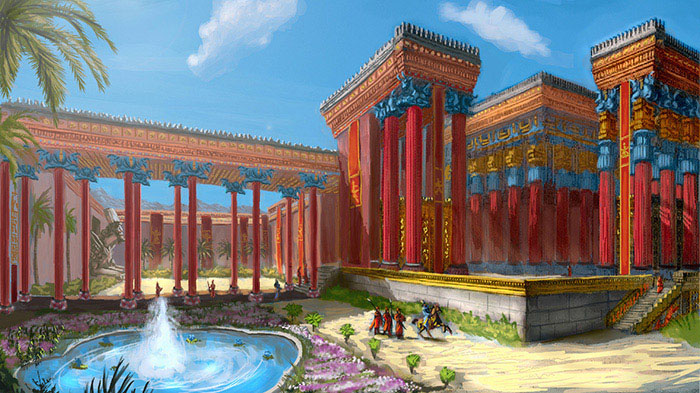
Beautiful young women were gathered to the palace from every province. Esther was advanced for this role by Mordecai, her adoptive father and guardian. For 12 months each woman underwent beauty treatments and Educational Importance of Royal Manners and Etiquettes in the Harem. They were then given anything they wanted or wished for to take with them from the Harem to the King’s palace. Most women chose luxurious colourful dresses, wore heavy makeup and carried as much gold and diamond jewellery as they could carry in order to catch the Kings Eyes and attention. When it was time for Esther to go to the king’s palace, she chose the simplest white dress she could find, wore minimum makeup and jewellery. Xerxes liked Esther more than he did any of the other young and beautiful women. None of them pleased him as much as she did, and right away he fell in love with her natural beauty, simplicity, sincerity and intellect and crowned her to be his wife and queen. In honor of Esther he gave a big dinner for his leaders and officials. Then he declared a holiday everywhere in his vast kingdom along with all the twenty-five countries that were part of his empire and gave expensive gifts to everyone. Both Esther and her adoptive father Mordecai became favourites in the Persian court.The name “Esther” comes from the Persian word: “star”.
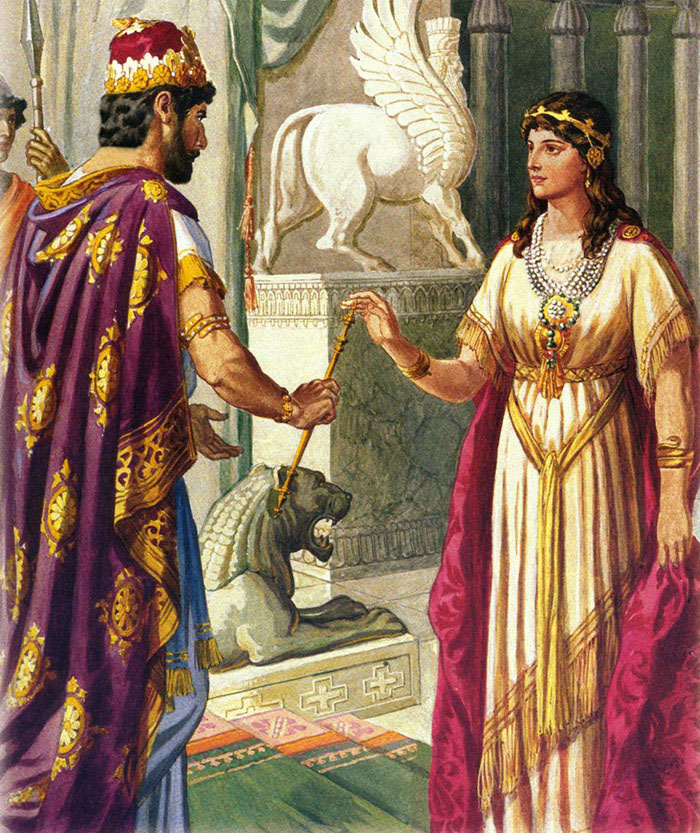
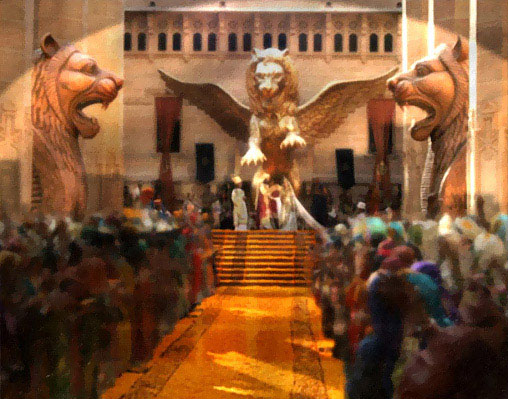
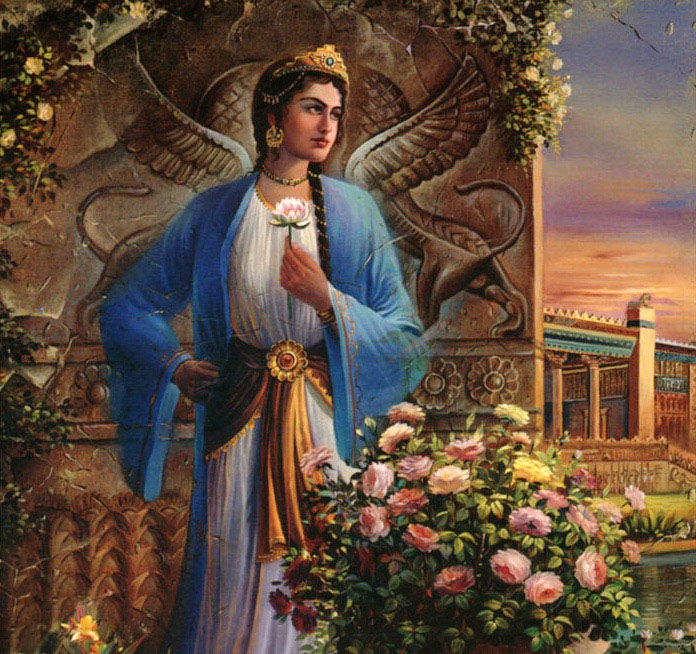
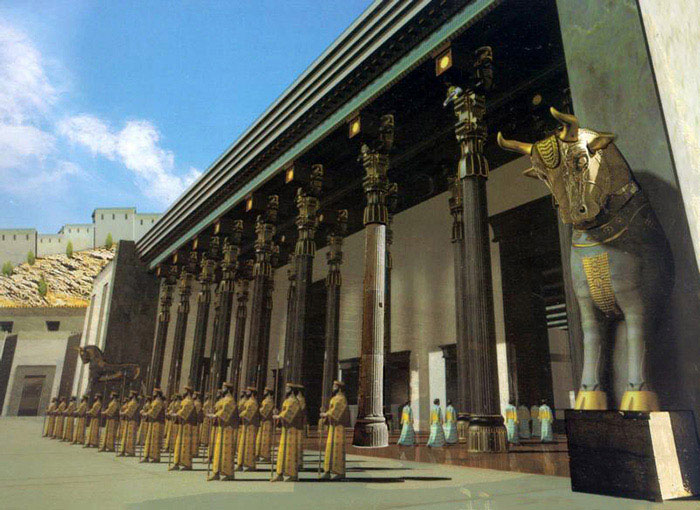
In January 334 B.C.E, The king of Macedonia: Alexander, Invaded Persia after his victory over the Persian army and reached Persepolis, the ceremonial capital of the Achaemenid Persian Empire. Alexander was an admirer of Persian Kings and especially Cyrus the Great. He conquered Persia but the Persian culture conquered him. He married with the Persian Kings: Darius III daughter: Princess Roxana and ordered all his generals and 10,000 of his soldiers to follow suit in a mass Persian wedding. Alexander tried to emulate the Persian court customs and attempted to create a new culture, a mixture of both Persian and Hellenistic.
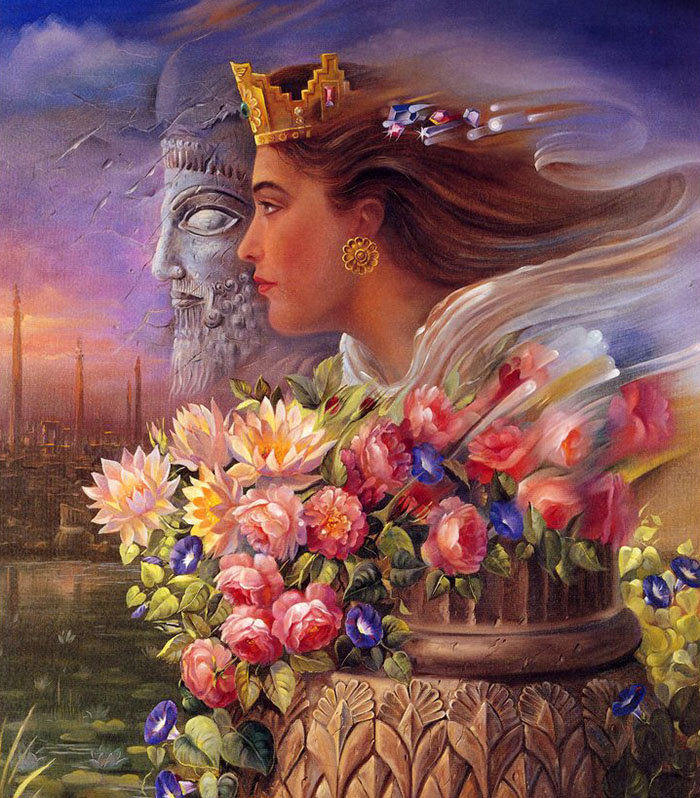
Alexander and his Army also plundered Persia, he ordered the execution of many Persians, allowed his troops to indulge themselves in plunder and rape and, in a drunken rage, set torch and destroyed Persepolis, the magnificent palace complex of the kings in revenge for all the Persian-Greek wars many centuries before and also because he was not yet the sole ruler of the Persian Empire, and it was too dangerous to leave the enormous treasures behind, where his enemies could recapture them. When Alexander conquered the Persians, he burned many of the grand buildings and libraries in Persepolis and destroyed or stole many of its royal treasures. The ancient painting below is showing Alexander’s troops burning and looting the palaces in Persepolis.
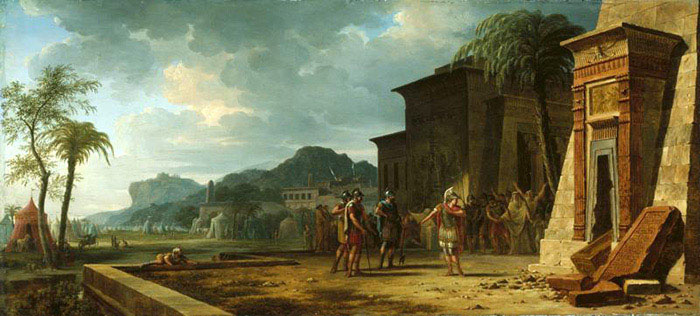

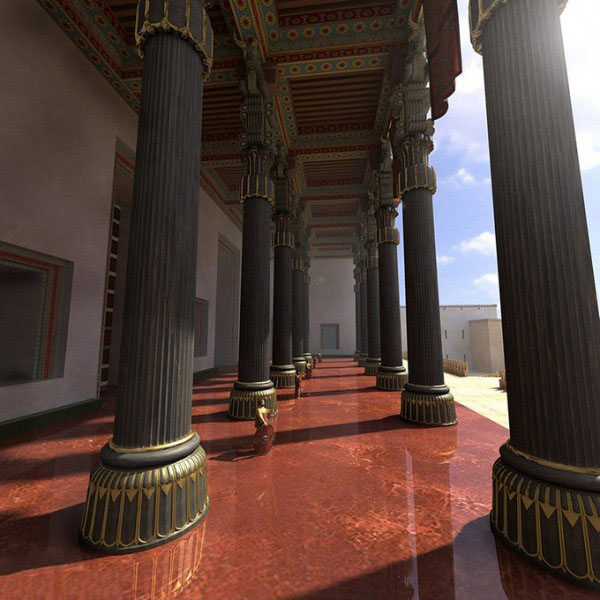
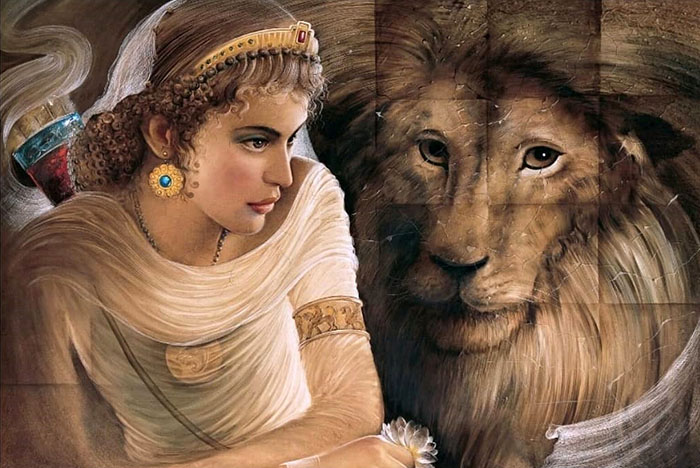
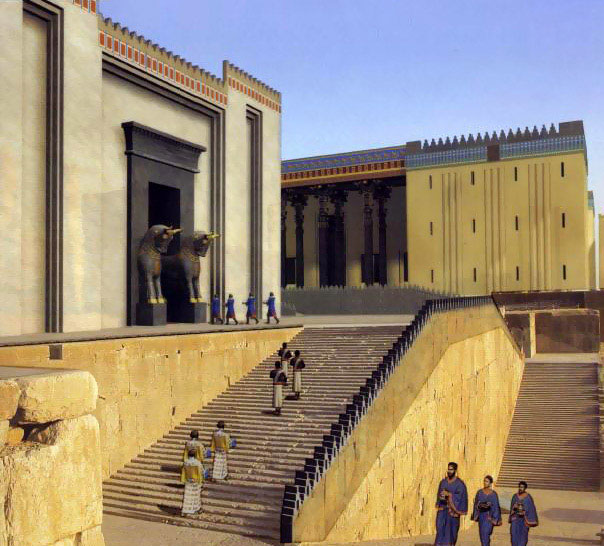
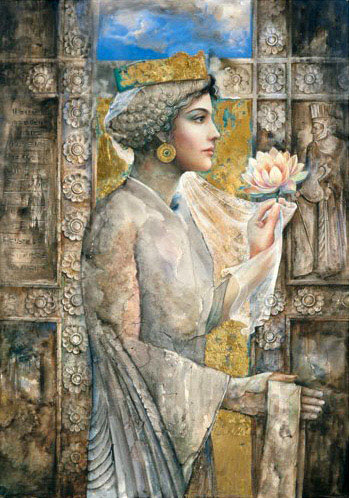
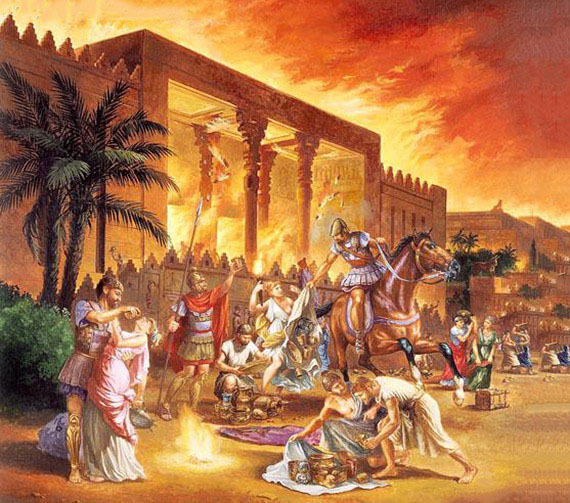

The Greco-Persian wars and Alexander’s victories proved that light-armed troops could not stop heavy, well-trained, and brilliantly led infantry of the type of hoplites or phalanx. These could only be encountered with even more heavily armed and highly professional cavalry causing disorder in the massed ranks and then attacking them on vulnerable points with bowshots capable of piercing armour and lances effective against shields. This lesson went home with the Parthians who in ousting the Seleucids from Persia formed their own professional armies and taking into consideration of what was needed against their enemies. Their victory over the Romans in 53 B.C.E. elevated the Parthian Empire into a superpower of their era.
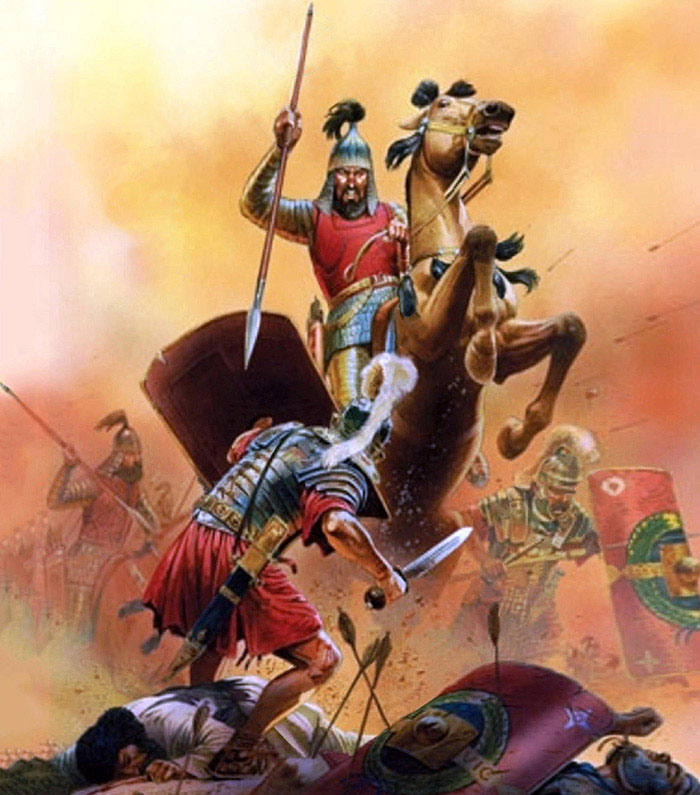
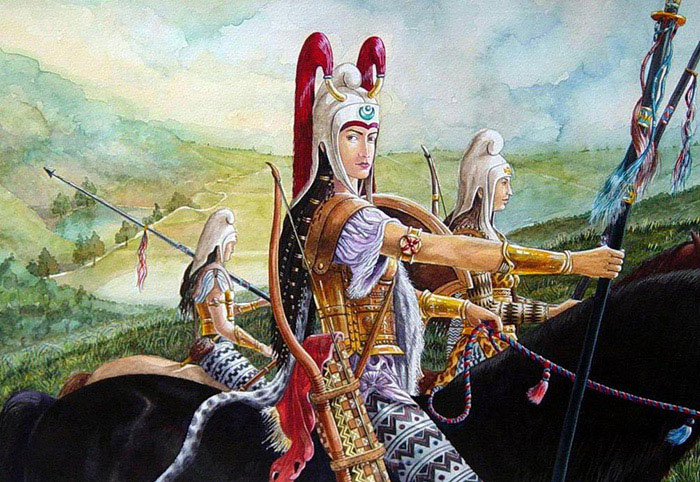
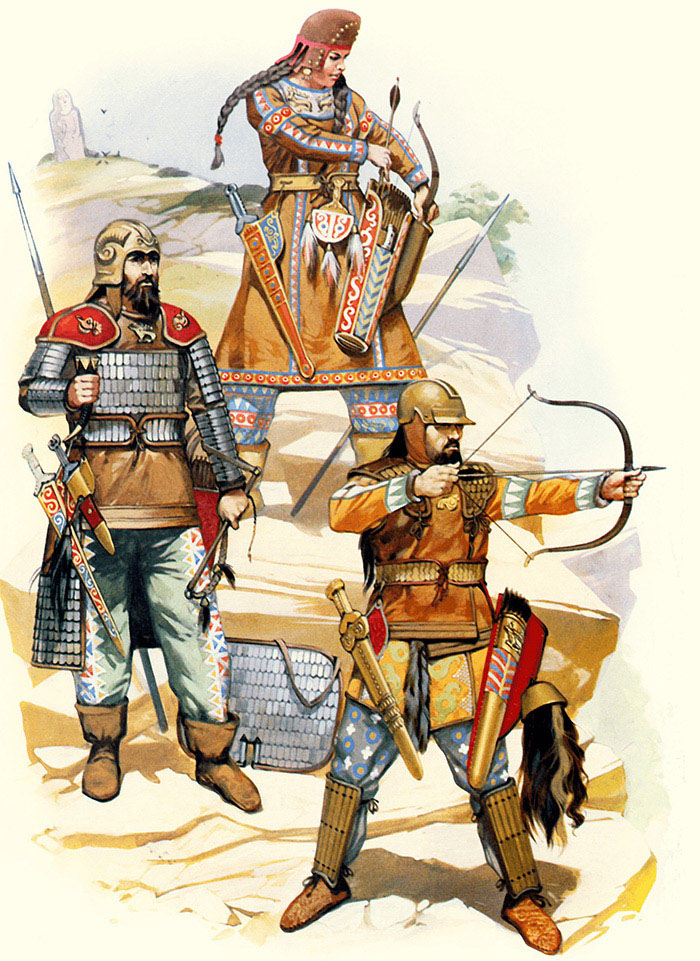
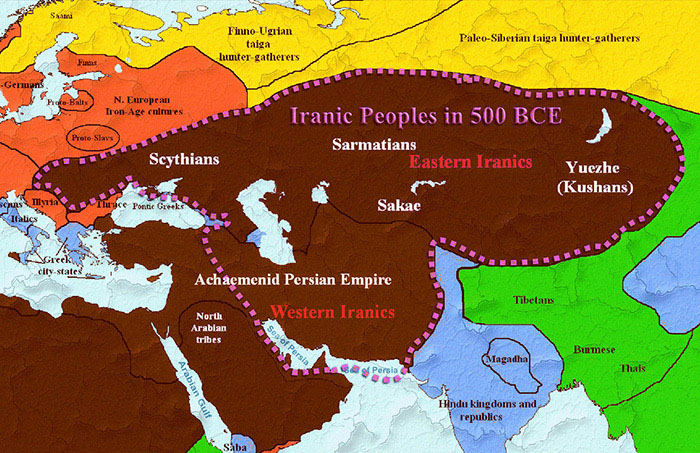
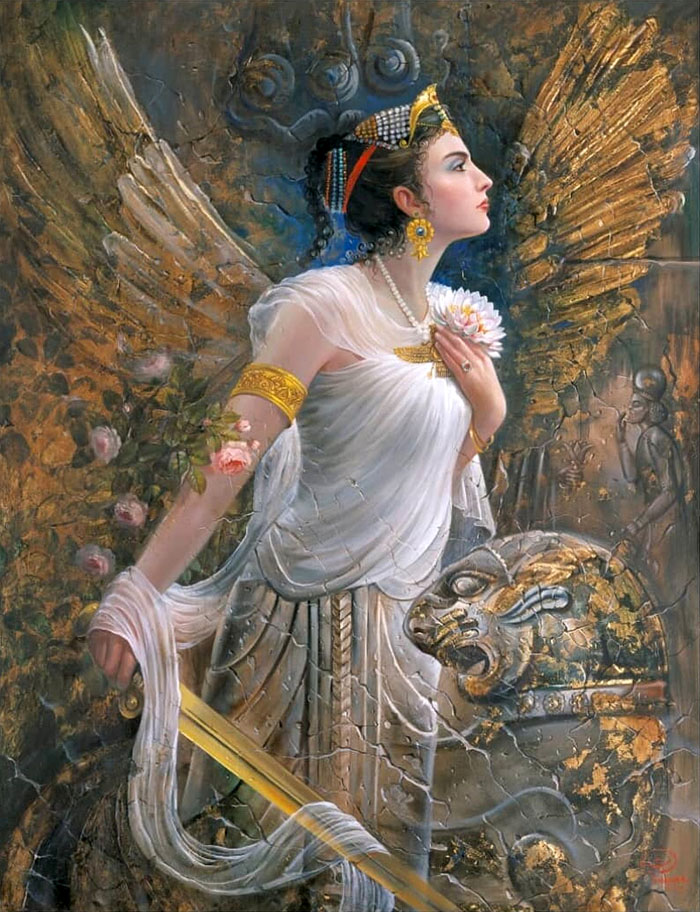
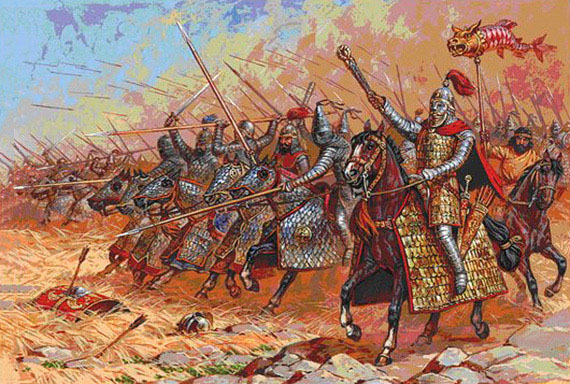
* Roman emperors always said that in order to Rule the World and acquiring new lands and control over the Silk Road you have to conquer Persia first (known to the ancient world as “The wealthiest empire under the sun”). The Romans also wrongly believed that two superpowers could never coexist peacefully and therefore their main goal was to conquer and destroy Persia but they never succeeded despite of centuries of wars and instead lost many wars that weakened their own empire and in the end left both empires very vulnerable against internal revolts and outside threat. The Romans tried to re-write history by calling great civilized and historical nations that they invaded and colonised (Greece, Egypt etc.) along with the entire Non-Roman world for “Barbarians” when in fact it was the other way around. Persians and Greeks viewed the Romans as the true bloodthirsty Barbarians of their era. continue »
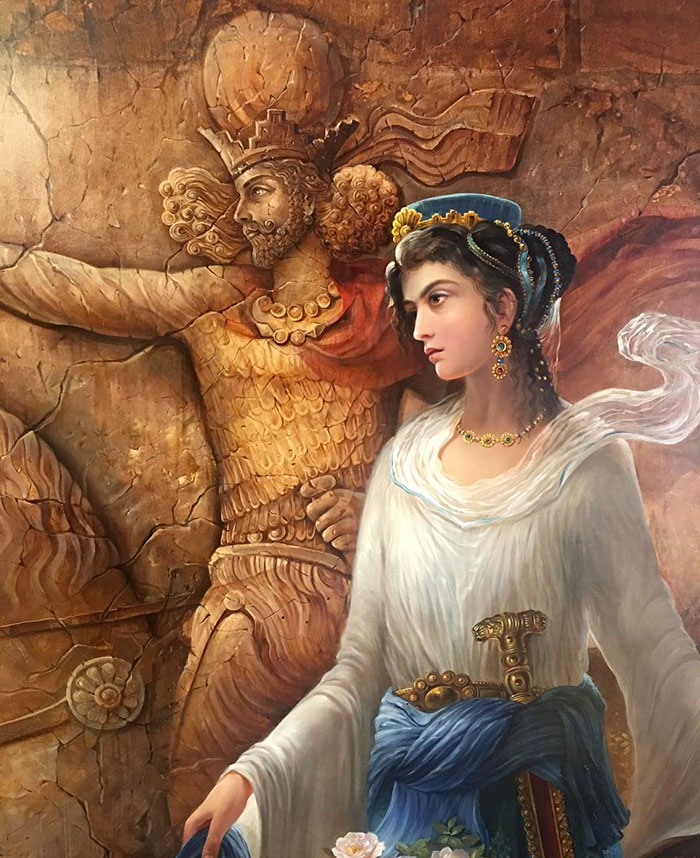
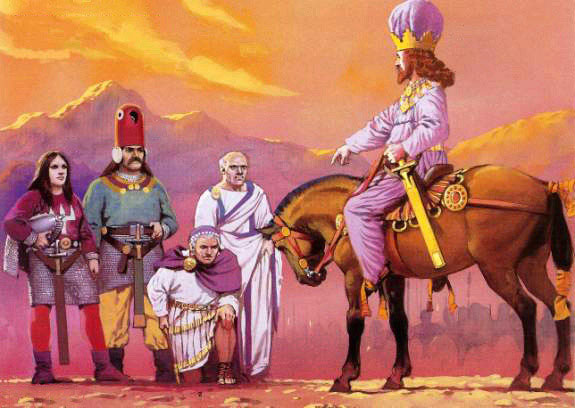
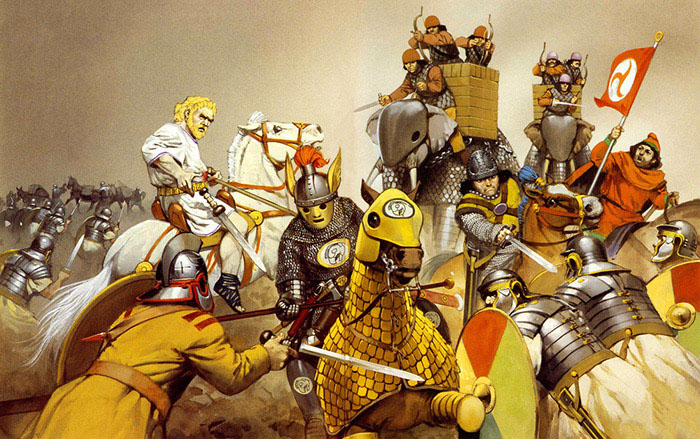

The Persian classical dance is not a dead art, frozen in time and endlessly repeated, but one that is both rich in heritage, and capable of adapting and incorporating elements from outside its tradition...

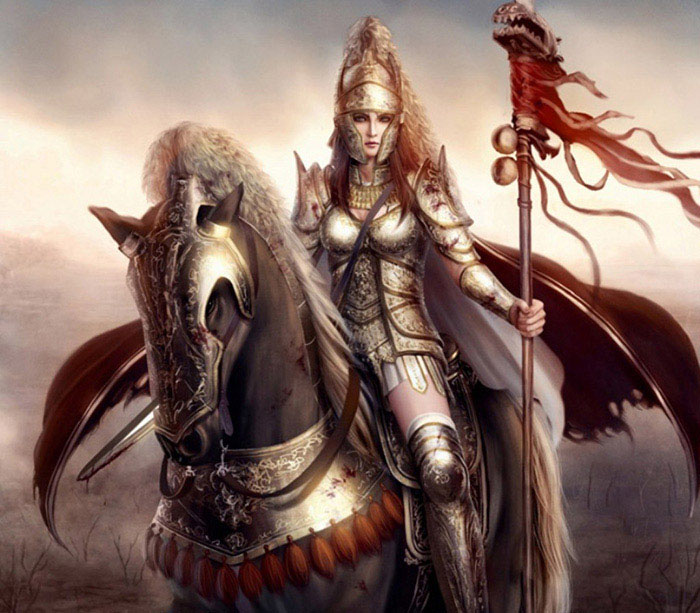
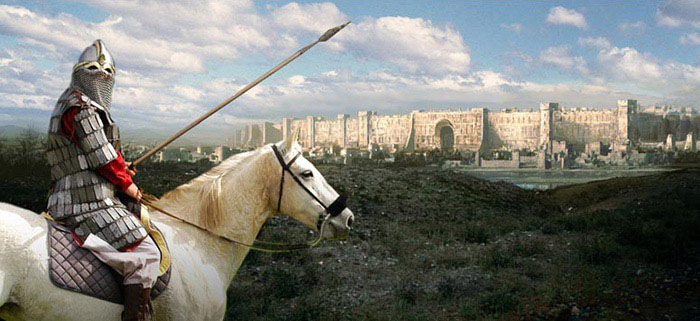
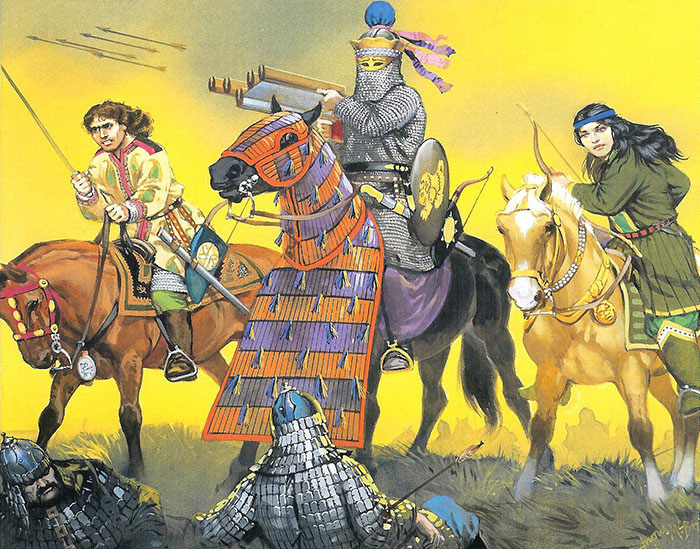
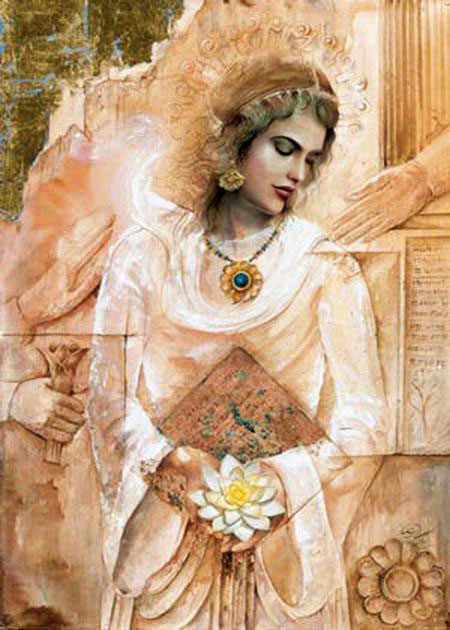
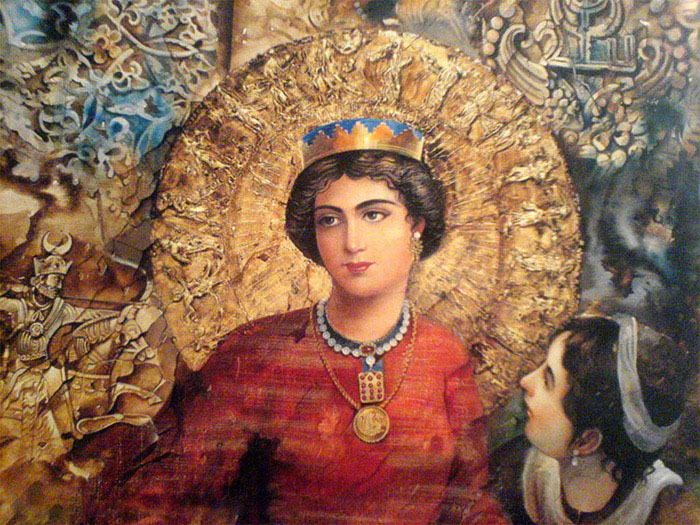
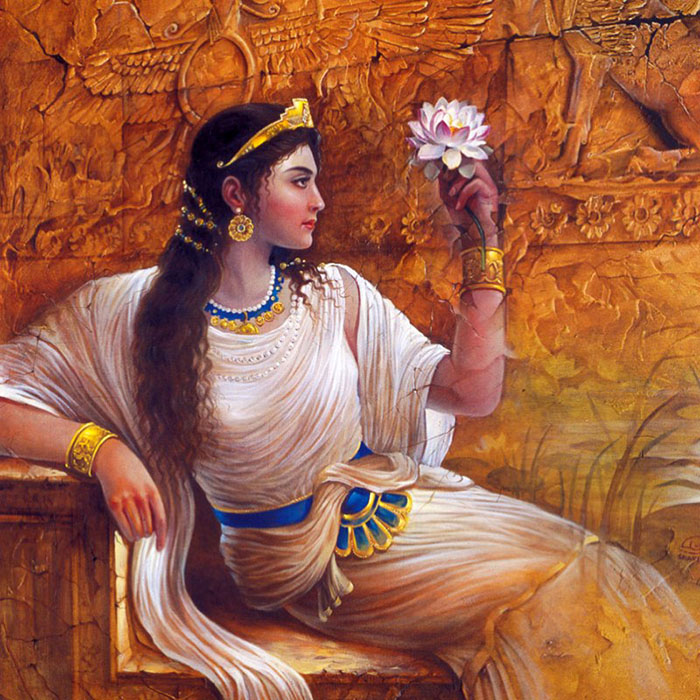
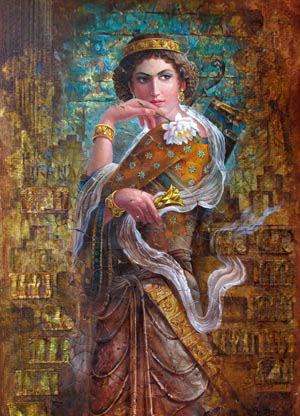

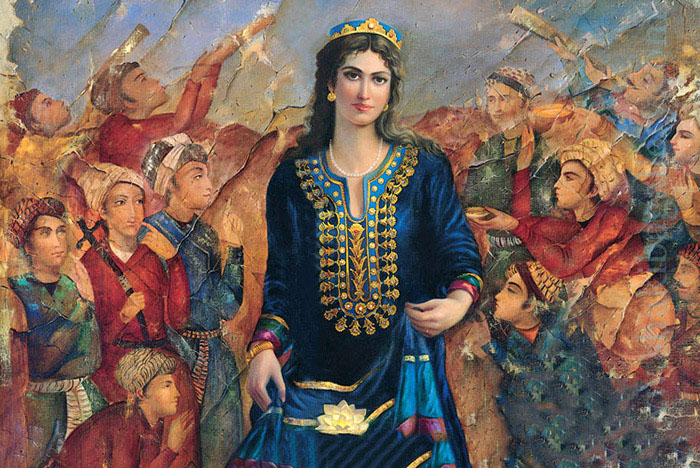
Apranik fully took the command of a major battalion of the Persian Army directly after the full-scale invasion and occupation by Arab armies and she led her devoted warriors against the Arab oppressors even after the loss of the Persian Empire and Sassanid Dynasty. As she got wiser, she found out that “Organized Warfare” with the Arabs or “The Desert Rats” as she refered to them, who invade and hide, and then reinforce and invade again, does not work; therefore, she started a campaign of a treacherous battle against the occupiers. For years to come, Apranik, first fought an official war and later on when all hopes were destroyed, Apranik, started her Hit and Run Rebellious Campaign until death. Apranik’s Dedicated Commando Warfare were legendary and relentless. Her white horse has always been a famous symbol of freedom and still is til this day.The name “Apranik” means: “Daughter of elder.”
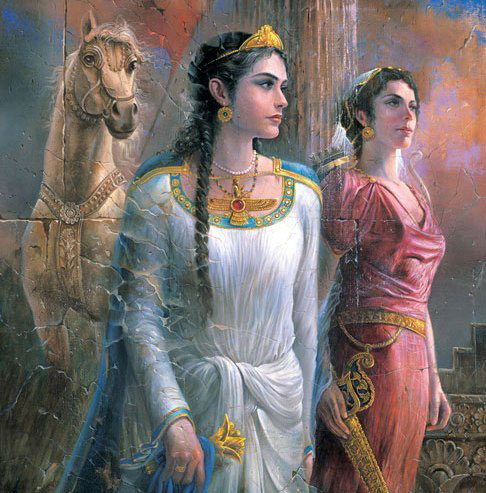
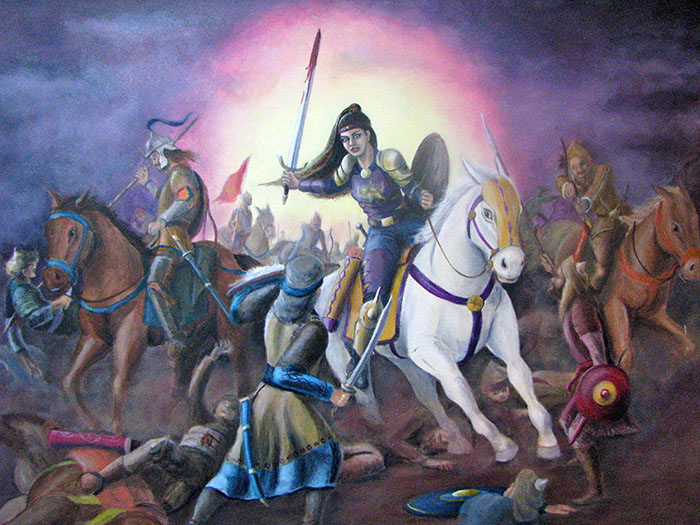
... Apranik and her Ranks, never surrendered, they have fought an on going bloody battle to the bitter ends. Apranik became a symbol for the “Persian Resistance & Freedom”. Her braveries were so known, that she became the talk of the “Persian Resistance” and Persians created an expression for her! Every time a female soldier would have shown bravery among the resistance, other soldiers would smile and call her: “Apranik”. Apranik’s famous words and policy were: “No retreat, no surrender”. Apranik acted as a battery charger for resistances spirit and chose to fight with her soldiers, until the bitter end, she chose to be cut to pieces by the Arab Sword, than to become a slave-whore in the Arab Bed... and eventually Apranik became a legend. The Legend of Apranik, is still living in every female freedom fighter of Persia’s heart. May her great spirit rest in peace. Apranik Daughter of renowned general Piran or as they used to call her “Apranik of Piran’s” will always be in the “Persian Resistance Hall of Fame”. This is what the Persian women were made of!
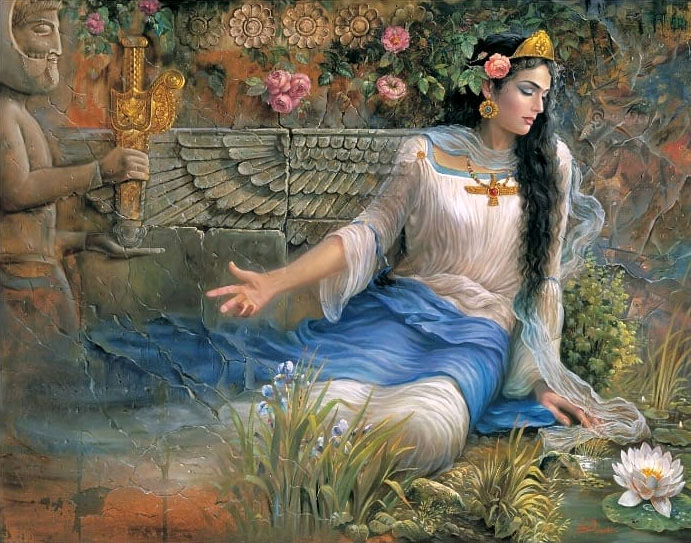


Eventually, Banu and Babak and their warriors were forced to leave “The Castle of Babak” (Ghaleye Babak) after 23 years of constant successful campaigns that killed over 500,000 invading Arabs and Babak’s mighty army (Red-Shirts) was never once defeated. According to historians of the era; For every Persian that died 10 Arabs followed them to the grave! They were eventually betrayed by one of their own officers and were handed over to the Abbasid Caliph. They lived and they died as Proud Persians until the last drop of blood was shed.
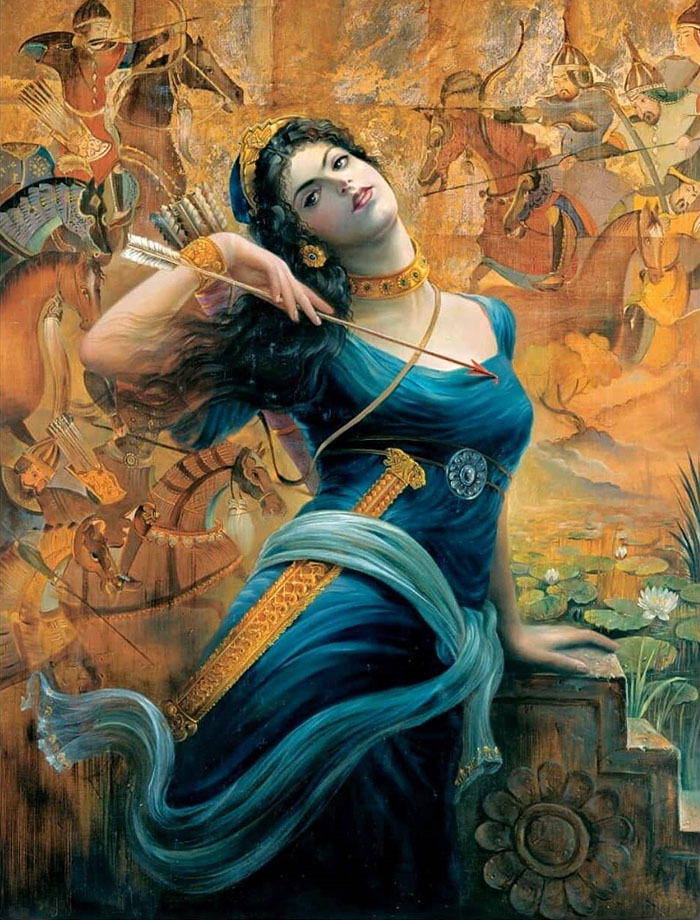
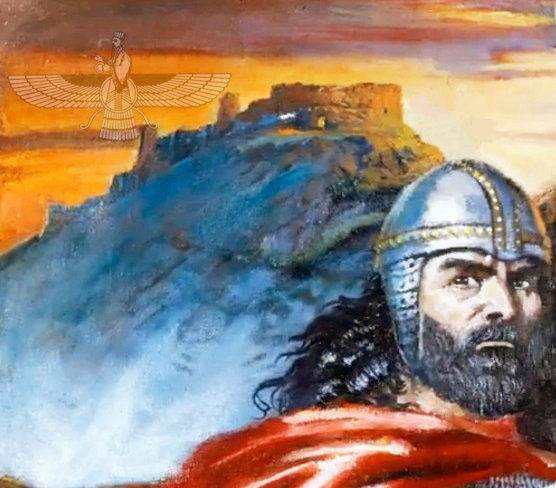
The head of Persian forces & the Grand General in charge of the defence “Rostam Farrokhzad” figured what the Bloodthirsty Arabs were fighting for... for their hunger, and their new God “Allah” and his so-called Holy War against the civilized World. (Arabs believed that they could rape & plunder the population and take anyone’s land, since God said that it was all theirs to take, and if they would die during the holy-war they would go directly to heaven and meet their 72 virgins). It was not possible for the Persians to fight an official war against the rebellious Jihadist Arabs who deliberately targeted un-armed civilians to spread fear and terror among the population. For the first time Rostam, “The Mighty Lion of Persia” as they called him... felt outnumbered and could finally see the End.. They thought the Sassanid Empire would last for thousands of years. Rostam stood in the front of his horse giving his last speech telling his army if he falls, he will take as many savage Arabs as he can. “Let this last day be the worse for them...” The persian borders falls, but the resistance from the people makes it more bloody though they were not armed, Resistance was led by a mighty woman named Apranik.
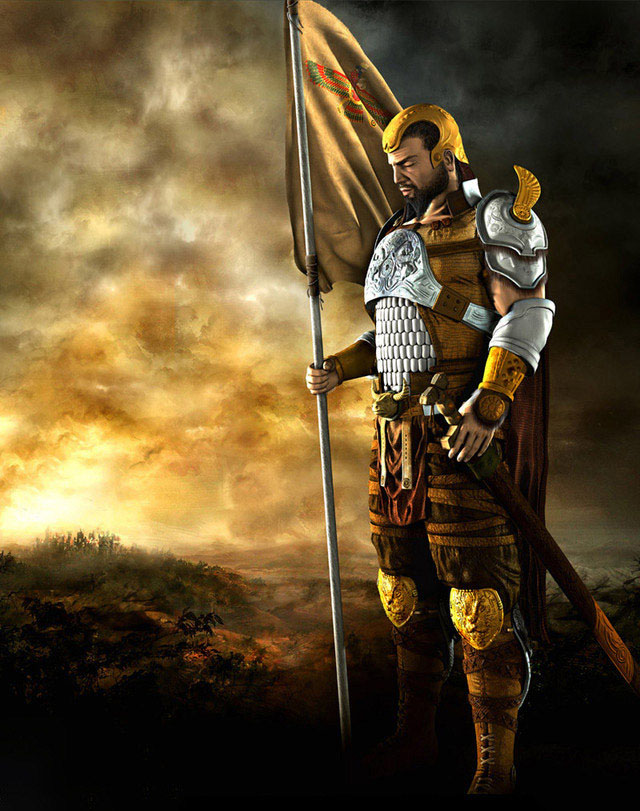

The history of Persians after the Arab conquest can be summarized in three words: oppression, misery and massacre. The Arabs invaded Persia not only for its reputed wealth, but to bring into the faith new converts and to impose Islam as the new state religion. They were religious zealots who believed that “in a religious war if one kills or is killed, one’s place in heaven is secure”. To impose the new religion, the old culture and creed had to be destroyed. Therefore first they targeted the libraries, universities and schools. Only few examples reflect the enormity of the calamity that befell upon Persia at 630 C.E. To conquer Persia and force Islam, the Arab invaders resorted to many inhumane actions including massacre, mass enslavement of men, women and children, and imposition of heavy taxes on those who did not convert.
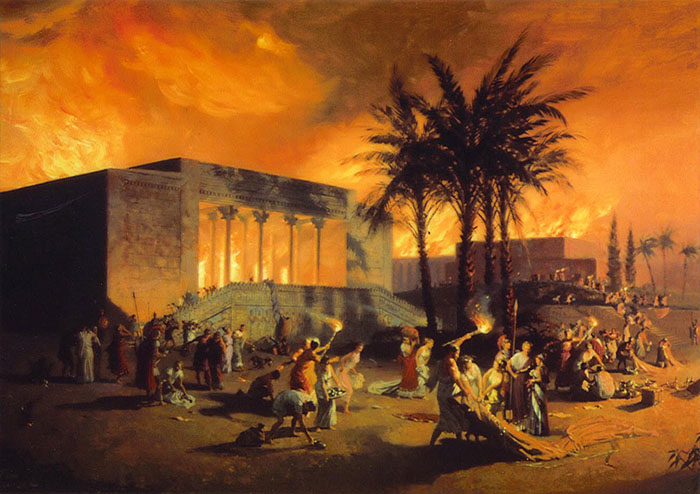
It was a tremendous loss. Our knowledge would be richer and, potentially, our path from the ancient world to the modern world would have been shorter and easier, had some of these works survived.

One of the Umayyad Caliphs was quoted saying: “milk the Persians and once their milk dries, suck their blood.”

“Persians have developed a surprising ability to adapt, but only outwardly, superficially & when absolutely required. Persian culture is both very strong & resilient. Iran was neither truly Arabized nor Islamized.”
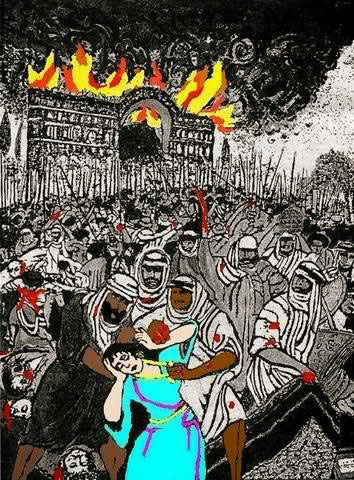
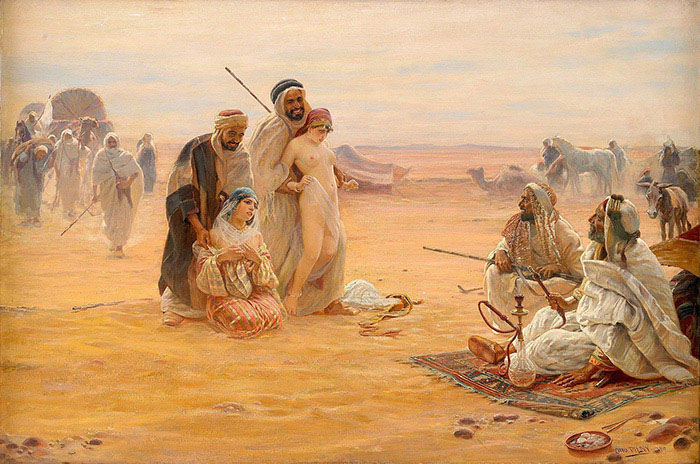
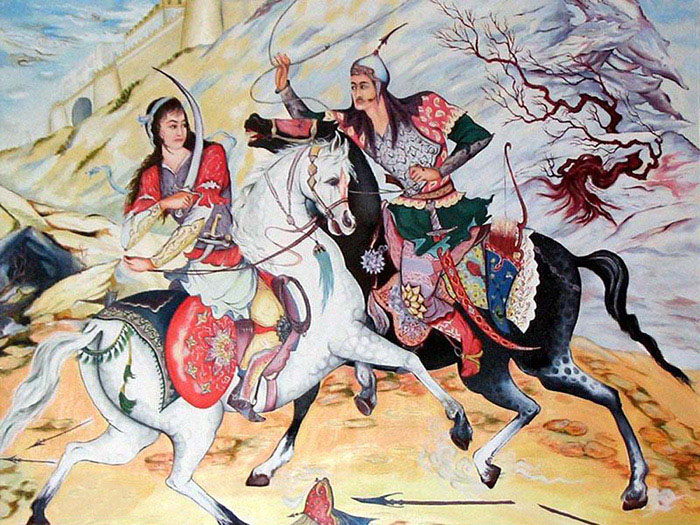
“It’s about being who you were born to be... a Queen...”The lost ancient Persian language was restored and it soon blossomed into one of the most poetic languages of the world. The Samanids were the first to adopt Persian as the official language of their court. Once again, Persia became a world center for art, literature and science. It was renowned for the impulse that it gave to Iranian national sentiment and learning. All the cultural, scientific and philosophical advances of the so-called Islamic world came out of Iran, and were advanced by Iranian minds. And so these advances were not Islamic, but Persian.
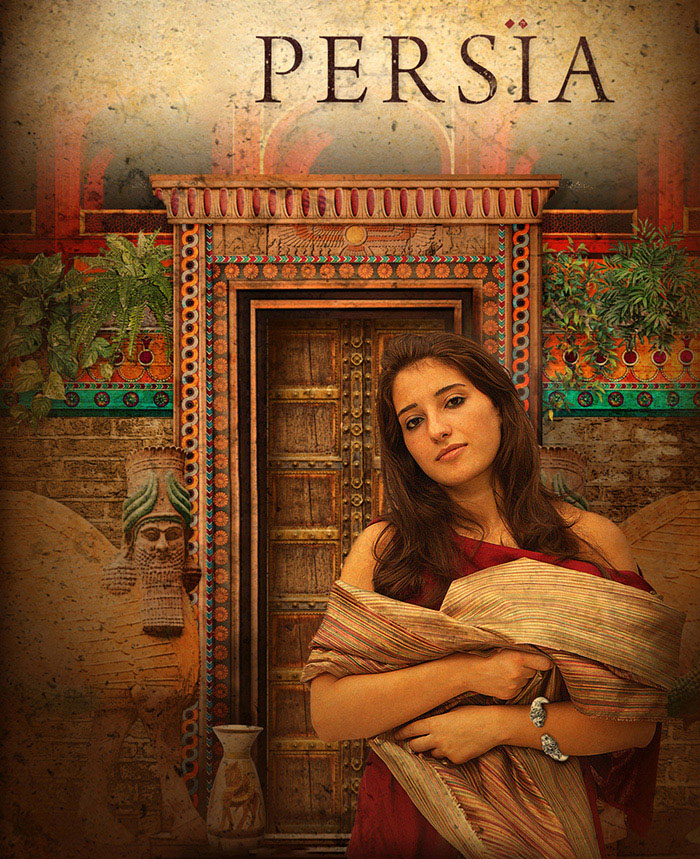
click here to read the entire timeline. A journey through time: 7000 B.C.E. to Present day. »
“Don’t forget our brave and mighty Lions and Lionesses!”For centuries Arabs has tried to destroy our culture, our language, science, poetry, literature, philosophy, religion, race, traditions, celebrations, music, arts and of course our Calendar. They never fully succeeded! Wake up Persia!
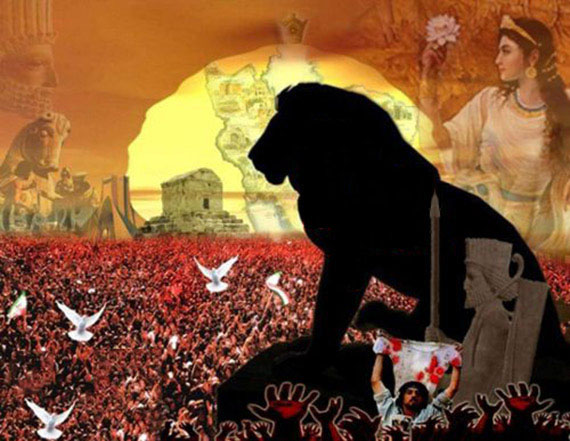
“A great civilization is not conquered from without until it destroys itself from within.”
“The Invaders Can’t Control What’s Inside Us”For us, there is no going back to the superstitions of the distant past. There is only the future, where Pan-Iranism, Atheism, Equalism, Democracy & Freedom awaits us... Today, there are an estimated 226 million Iranic people and Persian speakers worldwide.For millenniums when invaders came to Persia, the Iranians never become the invaders; the invaders became Iranians. Their conquerors were said to have “gone Persian,” like Alexander, who, after laying waste to the vanquished Persia, adopted its cultural and administrative practices, took a Persian wife: Princess Roxana, and ordered thousands of his troops to do the same in a mass wedding. Persians seem particularly proud of their capacity to get along with others by assimilating compatible aspects of the invaders’ ways without surrendering their own; a cultural elasticity that is at the heart of their Persian identity.

We would like to end by saying that we are certain that light will overcome darkness/fanaticism, and Persia, alike the legendary bird “Simorgh of Shahnameh”, will once again rise from her ashes and regain her rich history. Persia, has always been home to those who throughout history have fought for the idea of freedom and equality.
“May God (Ahura Mazda) always light your path and bless you with lessons to grow by!”
http://www.persepolis.nu/
--------------
Want to Destroy
ISIS? Deny Weapons to Saudi Arabia Until Their Women Can Vote and Drive
------------
The ISIS Crackdown on Women, by Women
ISIS's all-female brigade and
the slowly growing role of female jihadis
How ISIS Games Twitter
The militant group that
conquered northern Iraq is deploying a sophisticated social-media strategy.
The advance of an army used to be marked
by war drums. Now it’s marked by volleys of tweets.The Islamic State of Iraq and Syria (ISIS), the Sunni militant group that seized Iraq’s second-largest city last week and is now pledging to take Baghdad, has honed this new technique—most recently posting photos on Twitter of an alleged mass killing of Iraqi soldiers. But what’s often overlooked in press coverage is that ISIS doesn’t just have strong, organic support online. It also employs social-media strategies that inflate and control its message. Extremists of all stripes are increasingly using social media to recruit, radicalize and raise funds, and ISIS is one of the most adept practitioners of this approach.
One of ISIS's more successful ventures is an Arabic-language Twitter app called The Dawn of Glad Tidings, or just Dawn. The app, an official ISIS product promoted by its top users, is advertised as a way to keep up on the latest news about the jihadi group.
Once you sign up, the app will post tweets to your account—the content of which is decided by someone in ISIS’s social-media operation. The tweets include links, hashtags, and images, and the same content is also tweeted by the accounts of everyone else who has signed up for the app, spaced out to avoid triggering Twitter’s spam-detection algorithms. Your Twitter account functions normally the rest of the time, allowing you to go about your business.
Tweets Sent by ISIS's Social-Media App Over a 2-Hour Period
The app first went into wide use in April 2014, but its posting activity has ramped up during the group’s latest offensive, reaching an all-time high of almost 40,000 tweets in one day as ISIS marched into the northern Iraqi city of Mosul last week. On Sunday, as the media reported on the group’s advance toward Baghdad, hundreds of Dawn app users began sending thousands of tweets featuring an image of an armed jihadist gazing at the ISIS flag flying over the city, with the text, “We are coming, Baghdad” (see below).
The volume of these tweets was enough to make any search for “Baghdad” on Twitter generate the image among its first results, which is certainly one means of intimidating the city’s residents.
As a result of these strategies, and others, ISIS is able to project strength and promote engagement online. For instance, the ISIS hashtag consistently outperforms that of the group’s main competitor in Syria, Jabhat al-Nusra, even though the two groups have a similar number of supporters online. In data I analyzed in February, ISIS often registered more than 10,000 mentions of its hashtag per day, while the number of al-Nusra mentions generally ranged between 2,500 and 5,000.
ISIS also uses hashtags to focus-group messaging and branding concepts, much like a Western corporation might. Earlier this year, ISIS hinted, without being specific, that it was planning to change the name of its organization. Activists then carefully promoted a hashtag crafted to look like a grassroots initiative, demanding that ISIS leader Abu Bakr al-Baghdadi declare not an Islamic state in Syria and Iraq, but the rebirth of an Islamic caliphate. The question of when and how to declare a new caliphate is highly controversial in jihadi circles, and the hashtag produced a great deal of angry and divisive discussion, which ISIS very likely tracked and measured. It never announced a name change.
Media attention has focused, not unreasonably, on ISIS’s use of social media to spread pictures of graphic violence, attract new fighters, and incite lone wolves. But it’s important to recognize that these activities are supported by sophisticated online machinery. ISIS does have legitimate support online—but less than it might seem. And it owes a lot of that support to a calculated campaign that would put American social-media-marketing gurus to shame.
---------------









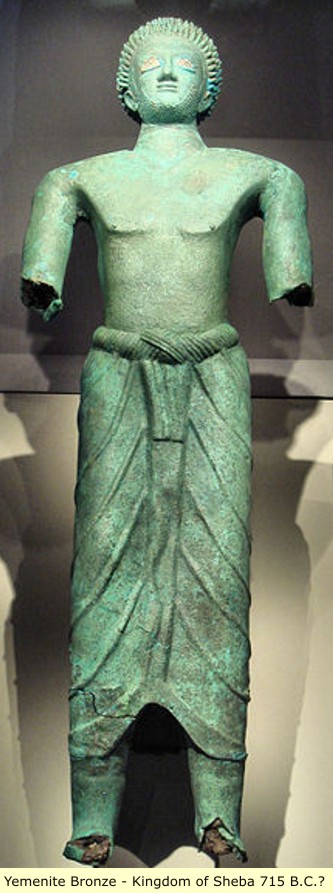
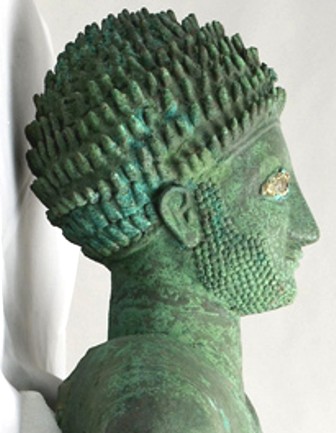
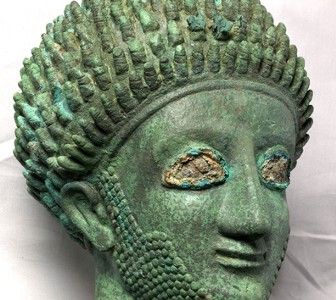


No comments:
Post a Comment
Note: Only a member of this blog may post a comment.